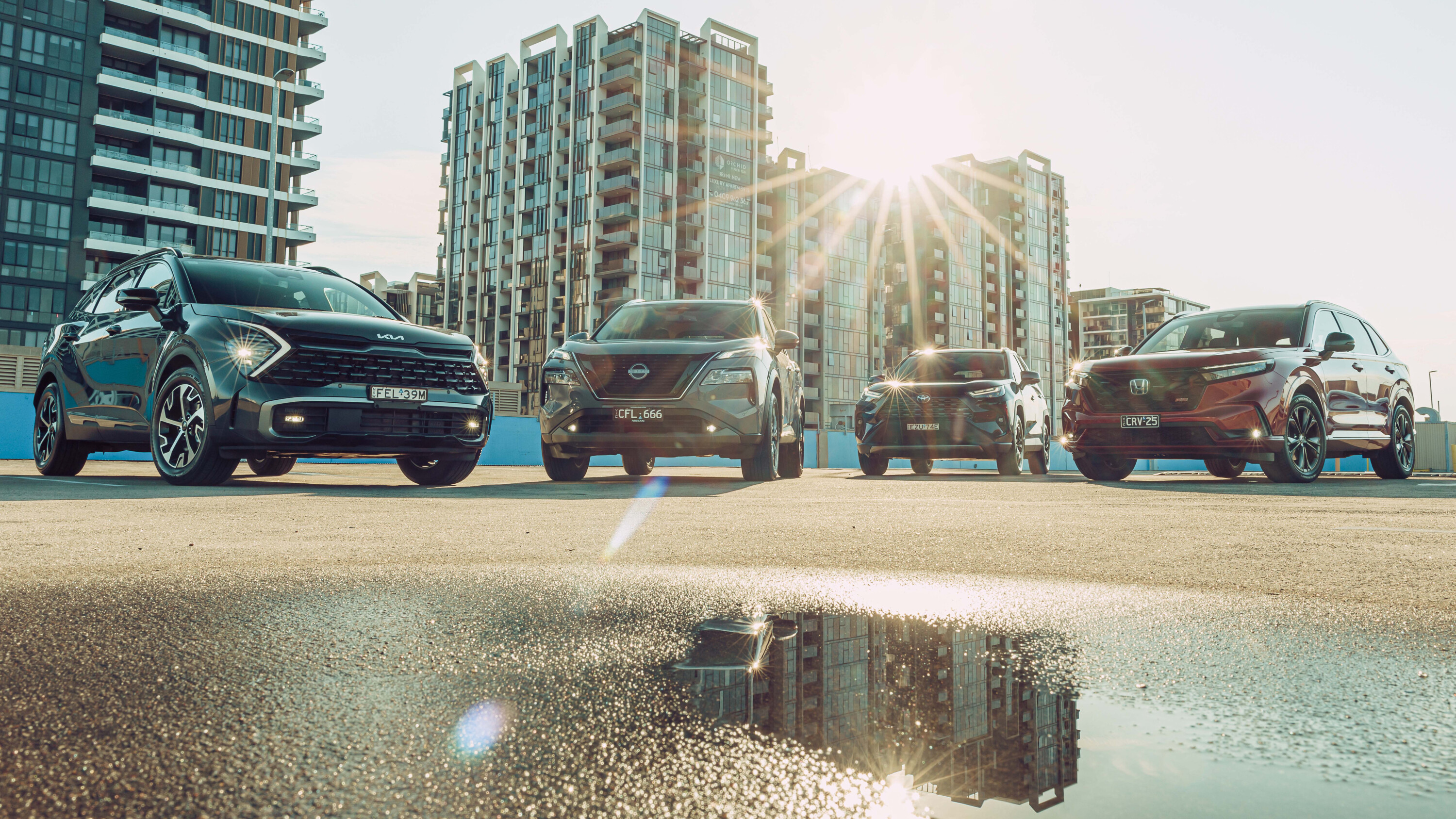Hybrids are on a roll, and nowhere more so than at the origin source – Toyota.
In April, the now-ubiquitous Hybrid drivetrain (in all its forms and capacities) surpassed 10,000 units in a calendar month for the first time for Toyota in Australia, and the now five-year-old, current-generation RAV4 nailed a monthly nameplate record – 5857 deliveries – of which a staggering 94 percent were Hybrid variants.
Stats like that carry enormous weight when it comes to configuring the competitor set for the all-conquering RAV4. With diesel variants having disappeared from many medium SUV model ranges in recent years, the efficiency heavy-lifting has been handed to petrol-hybrid engines.
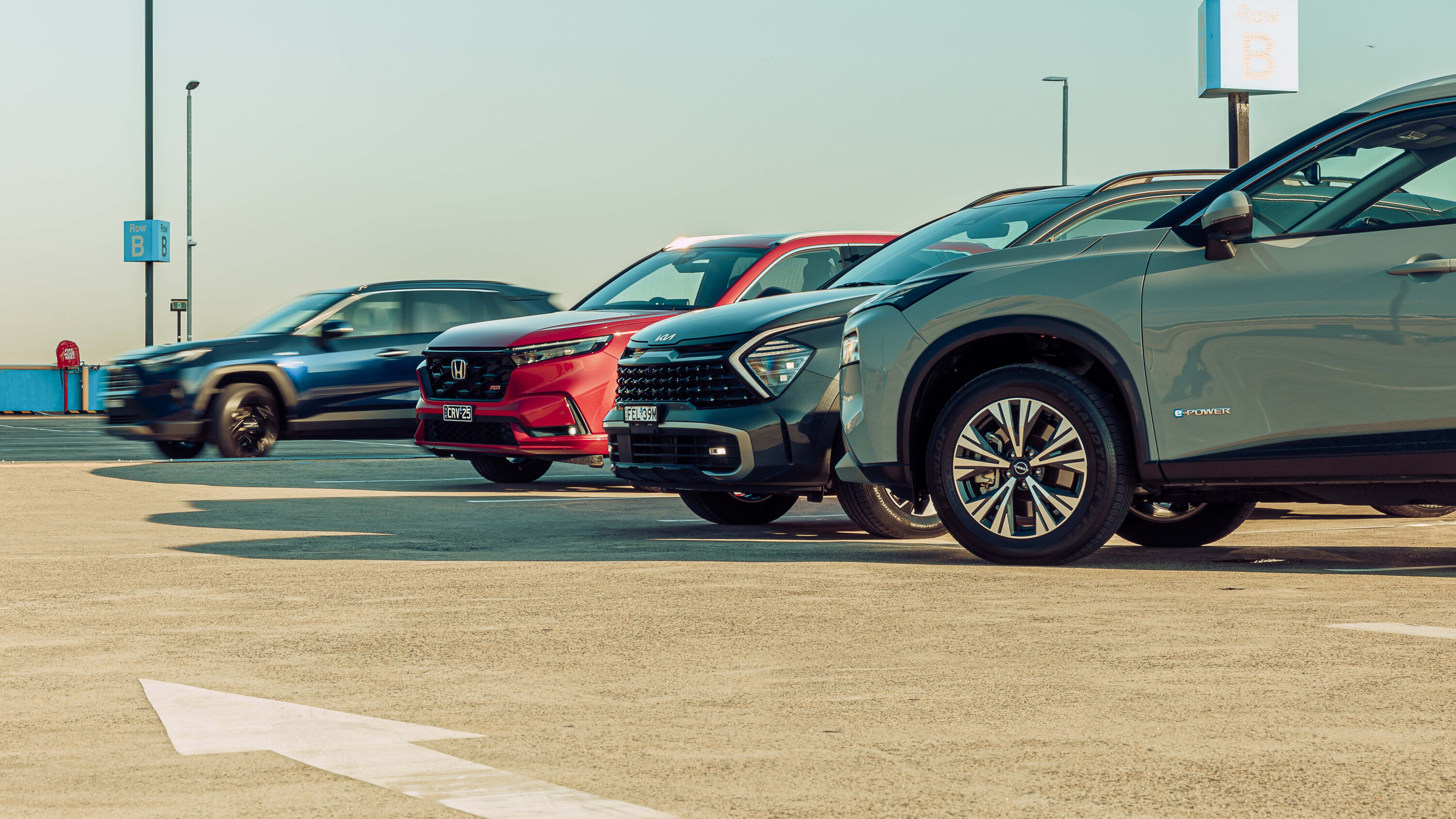
And given their combination of crisp performance, drivetrain smoothness and overall range, it has become the most intelligent alternative … within reason.
Fresh hybrids on display, such as the just-launched Kia Sportage Hybrid and the recent sixth-generation Honda CR-V with an exclusive hybrid flagship, have expanded their reach and swollen buyer choice, however we’re only testing what we consider to be the best medium SUV hybrids for this comparo.
That means no Haval H6 Hybrid ($42-$46K) due to its lack of sophistication and finesse, no Tank 300 Hybrid ($56-$61K) for a similar reason, and no Subaru Forester Hybrid ($44-$50K) given that it’s living on borrowed time in its current form, and the lacklustre hybrid version offers only minor efficiency gains.
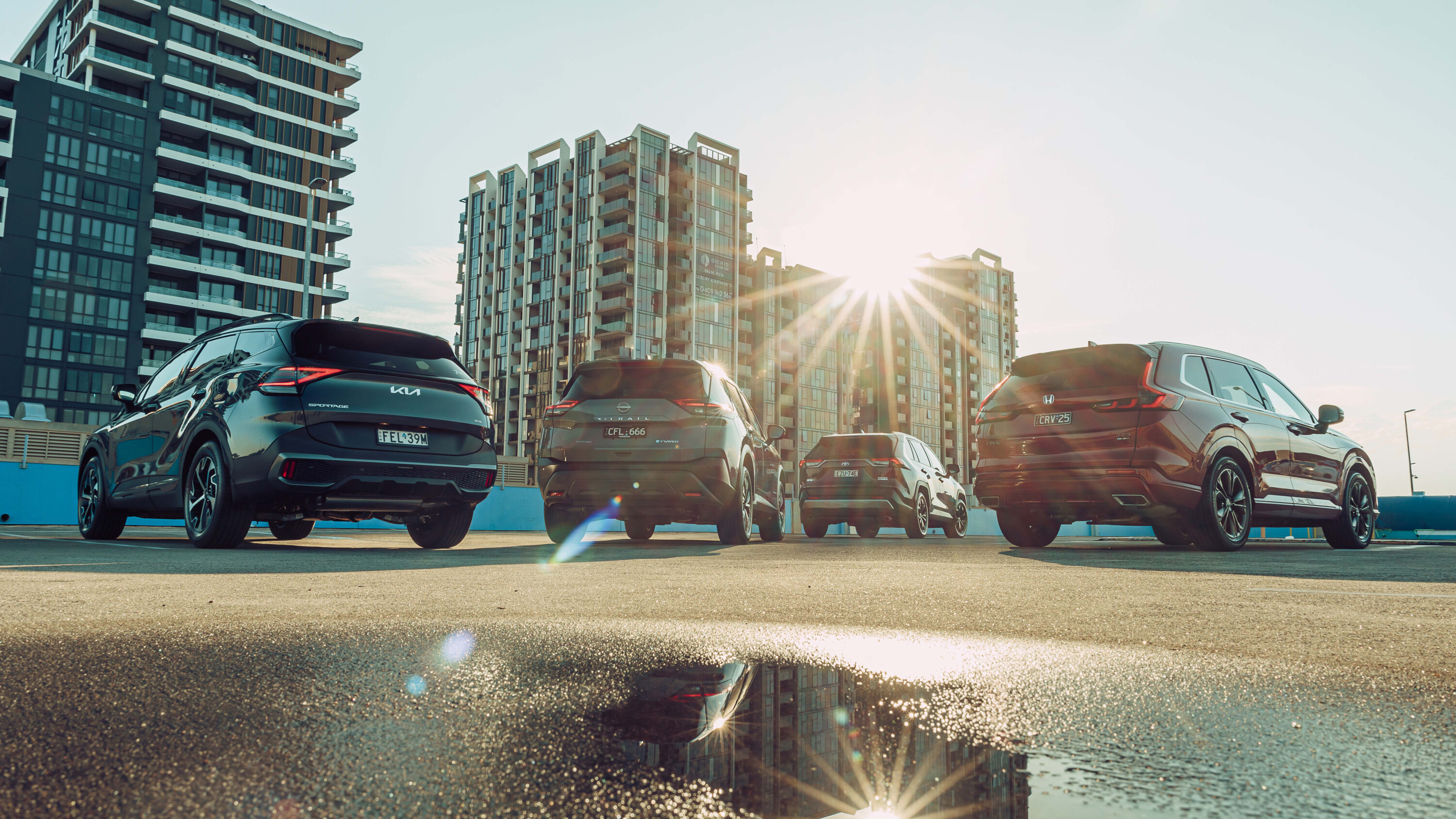
With punters favouring up-spec variants – and the fact that, for now, the CR-V e:HEV is only available in top-shelf RS guise – we’ve (mostly) stuck with the cream of the crop.
In RAV4 territory, that means a Cruiser Hybrid e-Four ($54,410), which we think is better value than the $4K-dearer Edge Hybrid. In the freshly electrified Sportage, the tech showcase is the GT-Line ($55,420), though it solely drives its front wheels.
The CR-V e:HEV RS ($59,900 drive-away) is also front-wheel-drive only, whereas the Nissan X-Trail e-Power ($50-$58K) treads an appealing middle-ground, offering three trim levels (ST-L, Ti, Ti-L), each with electric-motor-driven ‘e-4orce’ AWD, similar to the RAV4 ‘e-Four’.
To make this test a reality, we had to accept an X-Trail ST-L e-Power ($49,990), meaning the new base hybrid with vinyl seats and 18-inch wheels, and no fancy Nappa leather, 10-speaker Bose audio, panoramic sunroof or 20s like the rather flash Ti-L range-topper ($58,490). But we’ve previously driven all e-Power X-Trails so we won’t unfairly criticise the ST-L for accentuating any posterior sweating due to its plastic upholstery.
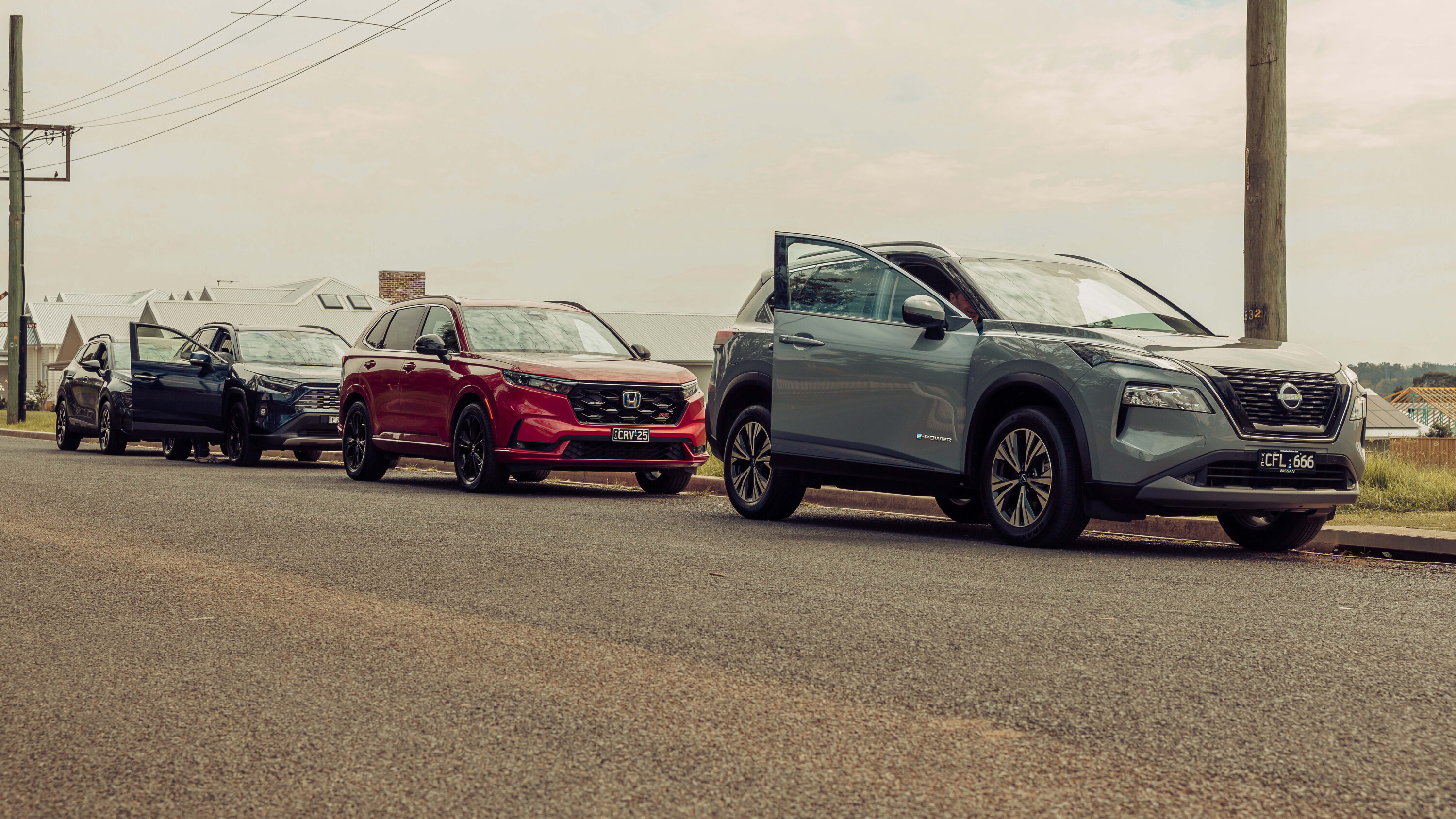
JUMP AHEAD
- Toyota RAV4 Cruiser hybrid
- Nissan X-Trail ST-L e-Power
- Kia Sportage GT-Line hybrid
- Honda CR-V e:HEV RS
- VERDICT
- Specifications
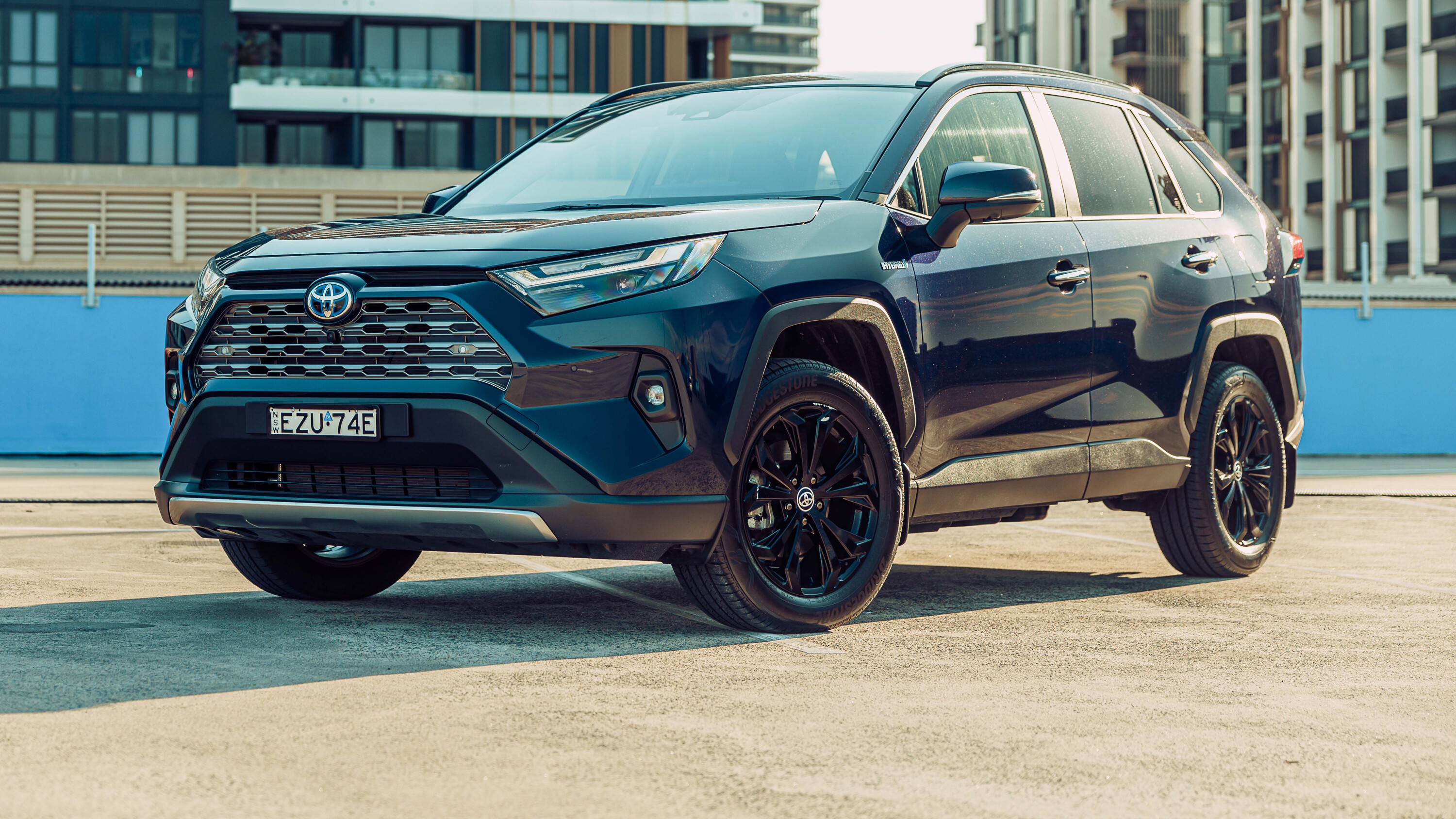
Toyota RAV4 Cruiser hybrid
If there’s a default in the matrix of medium SUVs, this is it – the petrol-electric Toyota RAV4.
Introduced as a replacement for the D4-D turbo-diesel in May 2019, the explosion in popularity of the fifth-generation RAV4 is purely down to its hybrid drivetrain – offered across the range since launch – as well as being infinitely better than its dull, mediocre predecessor (2013-19).
Indeed, from the moment we first drove it, the current RAV4 Hybrid has set the pace for other medium SUVs to follow if they wanted to match its enviable combination of pointy steering and handling, keen performance, benchmark efficiency, impressive space and comfort, and, by a considerable margin, class-leading resale value.
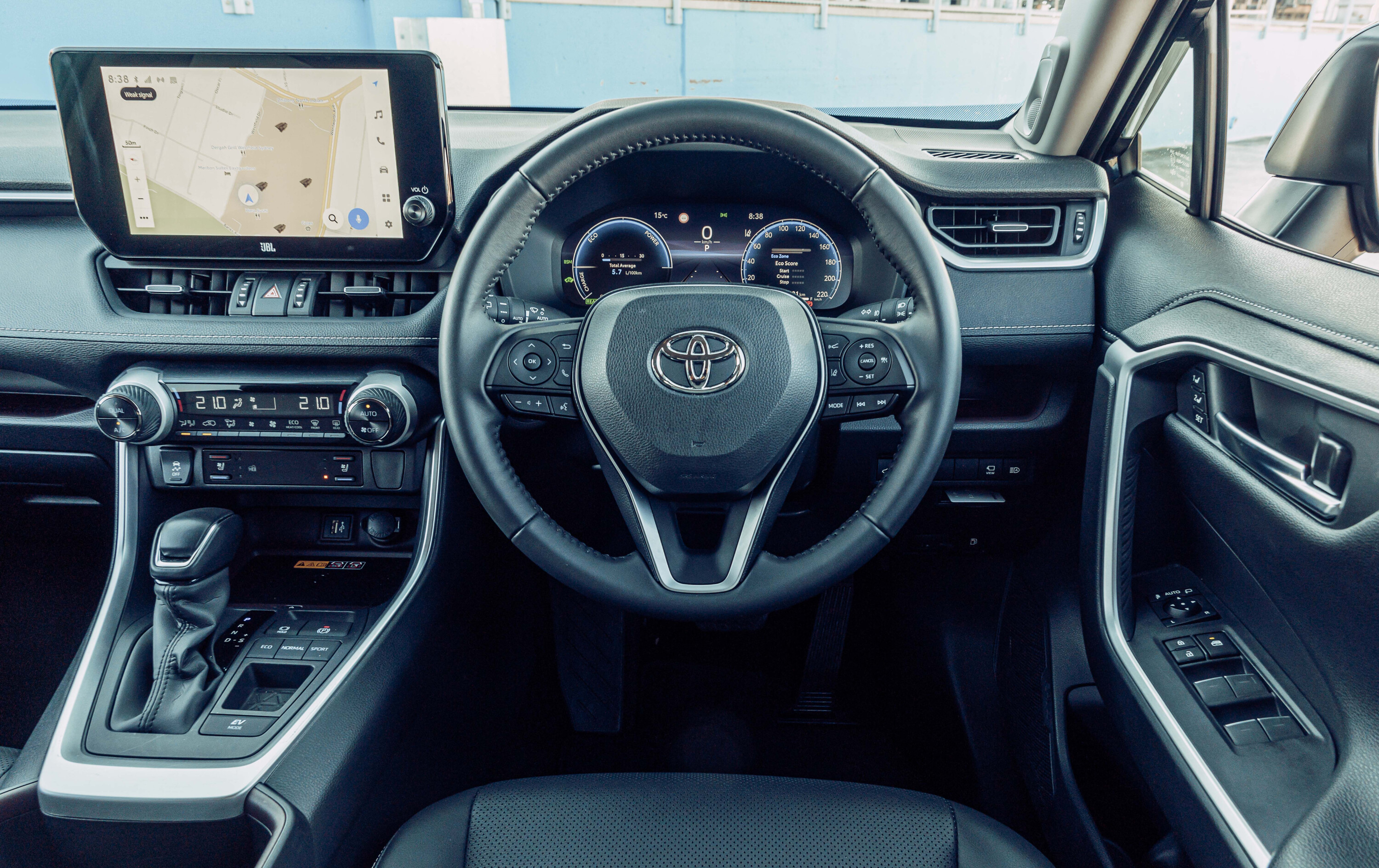
Toyota’s fairly consistent updating of the RAV4’s standard equipment and multimedia tech has maintained its value-for-money edge, however five years is a long time at the top in anyone’s language, and only now is the RAV4 Hybrid finally starting to feel its age.
Visually, its blend of Tonka-tough cabin plastics and robustly detailed design has never implied luxury – in this respect, it’s always been best-suited to the adventure-flavoured Edge flagship – and in 2024, that’s more evident than ever alongside the expensively finished CR-V and surprisingly slick X-Trail Ti/Ti-L.
Yet there’s a large-buttoned, simple-to-operate utility about it (apart from some multimedia clumsiness, mostly solved by wireless Apple CarPlay) that makes the Toyota feel pleasingly familiar and capable of copping a beating.

Its rubberised door grips define functionality and its driving position is excellent, with electric leather front chairs (10-way driver with lumbar and memory, 8-way passenger) each with heating and cooling.
The late-’22 addition of a 12.3-inch digital driver’s display and 10.5-inch multimedia touchscreen (cranking through a nine-speaker JBL audio system) have maintained the RAV4 Cruiser’s screen savvy, and its rear seat is supportive, too, with adjustable backrest rake, good vision, air vents and two USB ports.
Decent boot space as well – 580 litres with the floor on its lowest level – yet the Toyota can barely squeeze a one-litre camping bottle into its front doors, let alone its rears, which doesn’t quite nail the SUV utility brief. And neither does the Cruiser’s hatchback-sized sunroof, in comparison to the glassy panoramas showcased by its rivals.
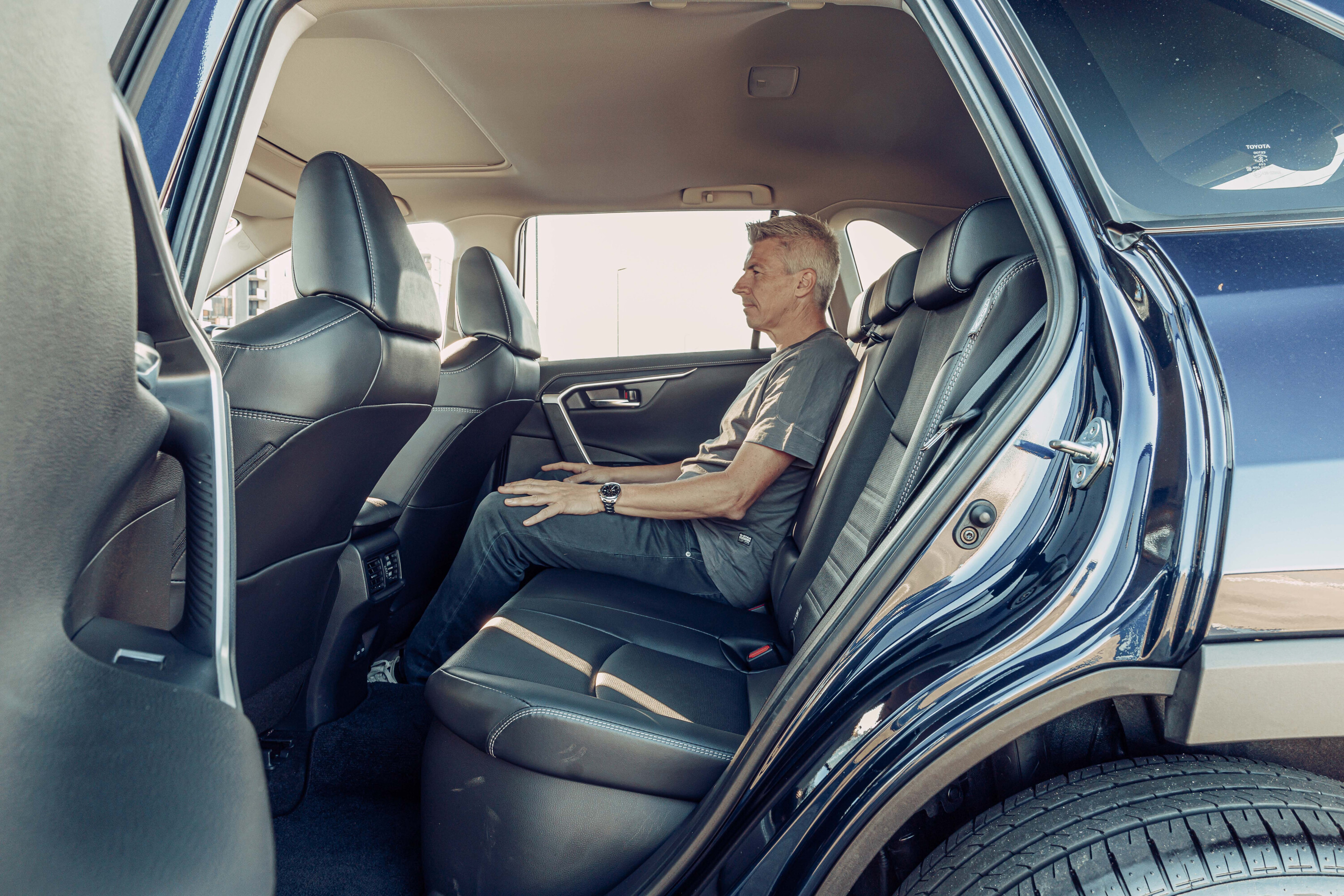
Drivetrain-wise, nothing has changed, meaning a 163kW 2.0-litre ‘Atkinson cycle’ petrol-electric hybrid four-cylinder driving through an e-CVT transmission and an all-wheel-drive system with an electric motor driving the rear axle.
It’s a robust and highly efficient set-up, delivering the lowest on-test fuel economy (5.6L/100km) but also the loudest engine noise once acceleration demands more than just battery power.
Right foot flat, its CVT transmission sends engine revs stridently soaring, which in isolation is far from unpleasant, yet it lacks the sweet-spinning character of the Honda, the serious performance of the Nissan, and the quieter nature of the Kia.

And the Toyota continues that trend with its suspension refinement – sending noticeably more road noise up into the cabin and experiencing moments on our challenging road loop where its comparatively brittle ride slapped its bump stops, rather than absorbing the hit.
That behaviour fails to detract from the RAV4’s fun-to-drive nature, because it really does feel light on its feet and change direction well. But there’s now a comparative graininess to its personality that wasn’t so noticeable before.
As its rivals have become smoother and slicker in all departments, the five-year-old RAV4 Cruiser Hybrid has remained steadfastly capable – but must now cede excellence in several areas to its fresher alternatives.
One thing that hasn’t changed, however, is the appeal of Toyota’s ownership credentials.
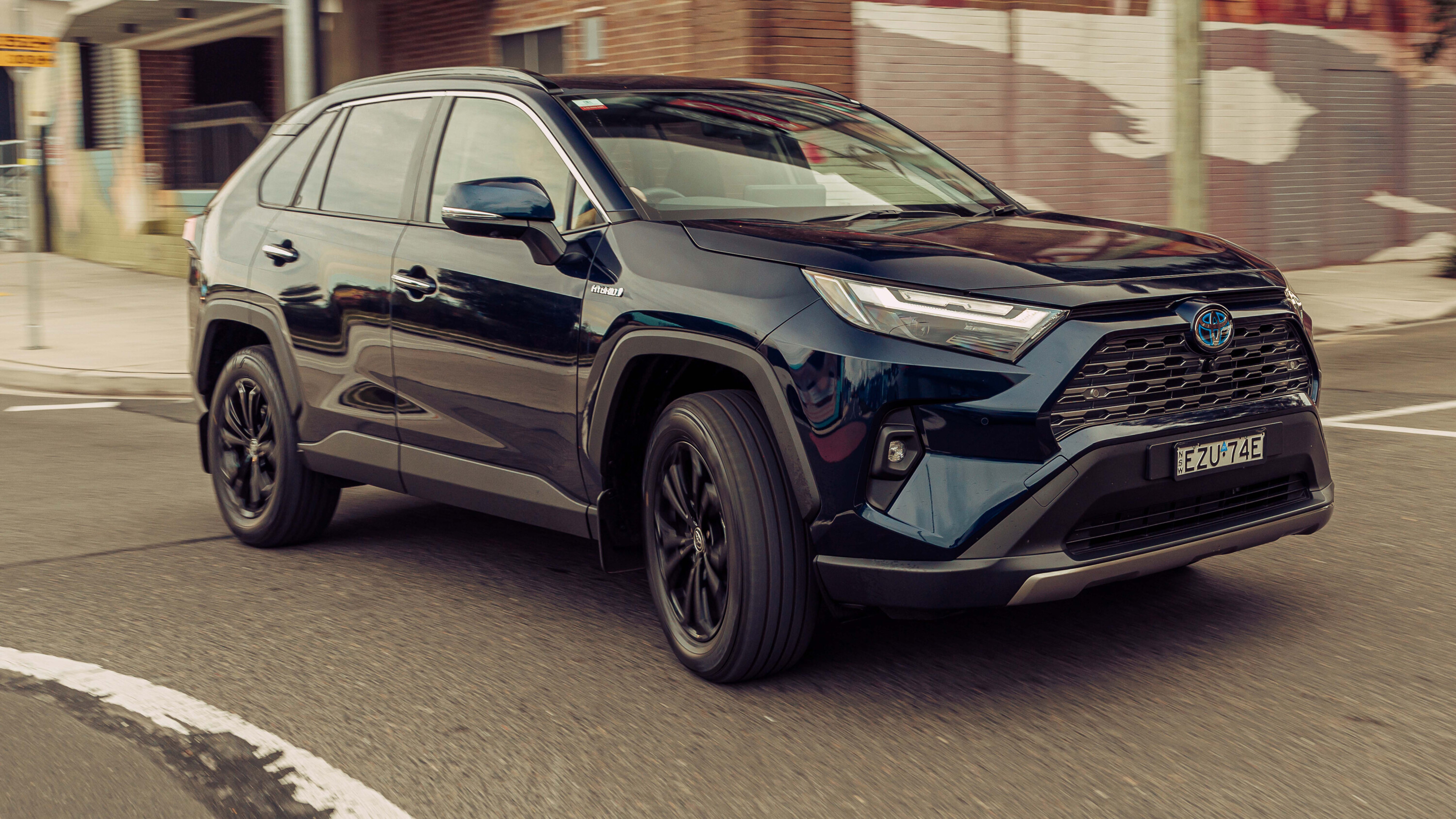
RAV4’s capped-price servicing is just $260 a year (or every 15,000km) for the first five years (or 75,000km), and if you stick to your service schedule, Toyota will extend the unlimited-kilometre driveline warranty from five years to seven.
And, according to The Red Book, the Cruiser Hybrid’s projected three-year retained resale value is over 10 percentage points higher than the next-best Honda and Kia, and 13-15 points better than Nissan’s e-Power line-up.
All that, combined with RAV4’s class-leading fuel efficiency and its reliability reputation, will be enough for many people to overlook the crow’s feet that are starting to show. But the hybrid-engined medium SUV game has definitely moved on, however incrementally.
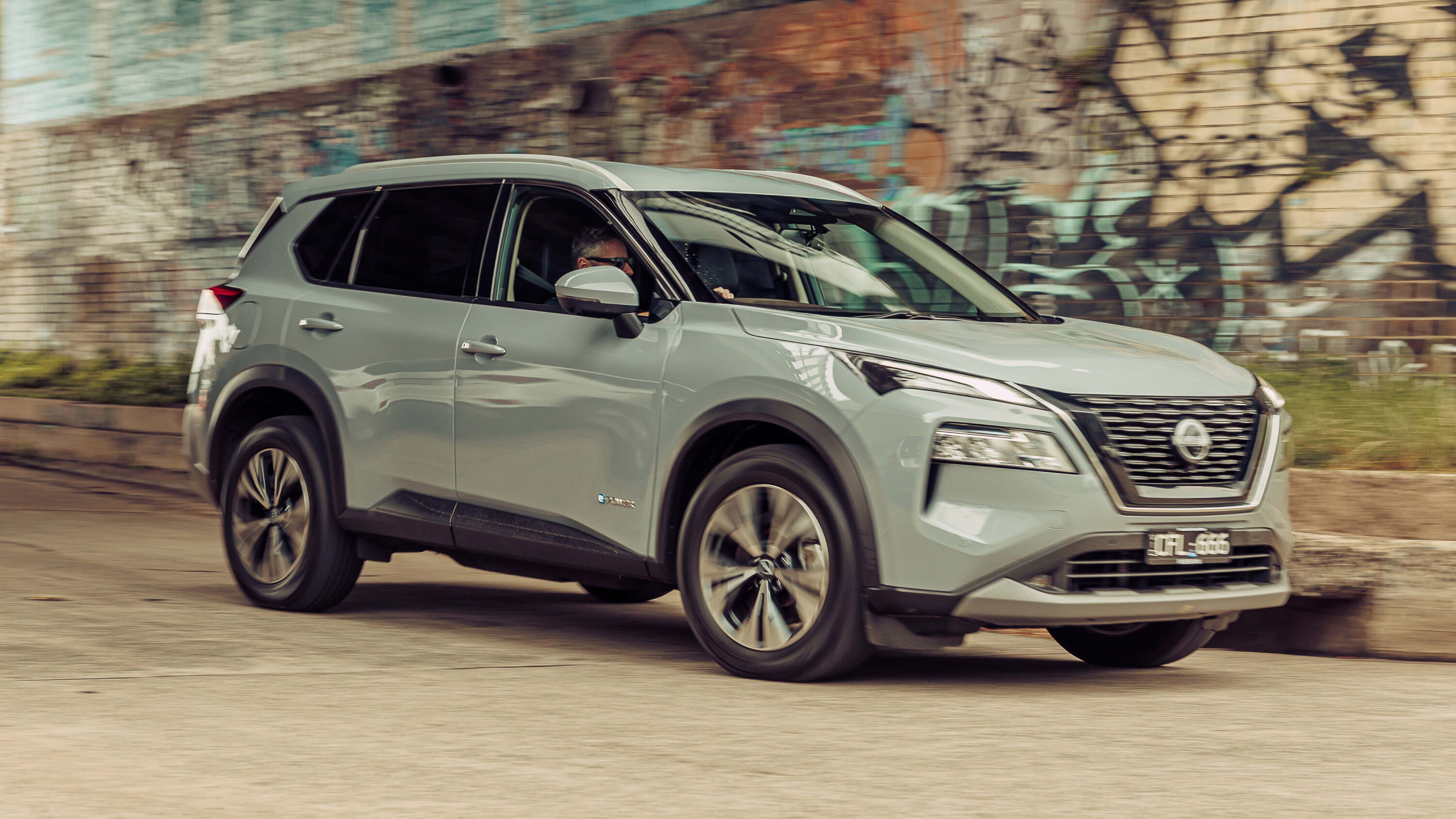
Nissan X-Trail ST-L e-Power
It’s refreshing to be able to approach a Nissan X-Trail without sensing an aroma of disappointment. The original version (2001) had a slightly quirky coolness about its design but it wasn’t good to drive.
The second-gen X-Trail (2007) uglified the styling while failing to make any headway on improving refinement. And the third attempt (2013), which seemed surprisingly decent at launch, was quickly outshone by more sophisticated rivals and received only superficial alterations throughout its nine-year lifespan.
The fourth-generation T33 X-Trail, however, is genuinely competitive – both in comparison with its chief rivals and, perhaps surprisingly, its Mitsubishi Outlander platform relative. And that sentiment applies wholeheartedly to the intriguing e-Power hybrid variant, which not only brings some engineering advances to the sector, but also serious performance.

Yes, that description relating to an X-Trail still sounds odd, but in the 157kW e-Power e-4orce, it’s genuinely true.
Nissan’s 0-100km/h claim is 7.0 seconds (compared to around 8.0sec for the RAV4 and Sportage, and 9.4sec for the CR-V), and the X-Trail e-Power’s rolling acceleration is so strong that it smashes the RAV4 when it comes to overtaking punch – pinning you back in your seat like no X-Trail in existence… apart from maybe the X-Trail GT (with a 206kW boosted SR20 kids!) offered only in the original generation in Japan.
What makes the e-Power drivetrain different is what makes it better. Perhaps not from a pure fuel-efficiency perspective because the hybrid X-Trail’s official combined consumption is 6.1L/100km (compared to 4.8 for the RAV4 e-Four, 4.9 for the Sportage Hybrid and 5.5 for the CR-V e:HEV), though the difference between all four on test was only 0.6L/100km.
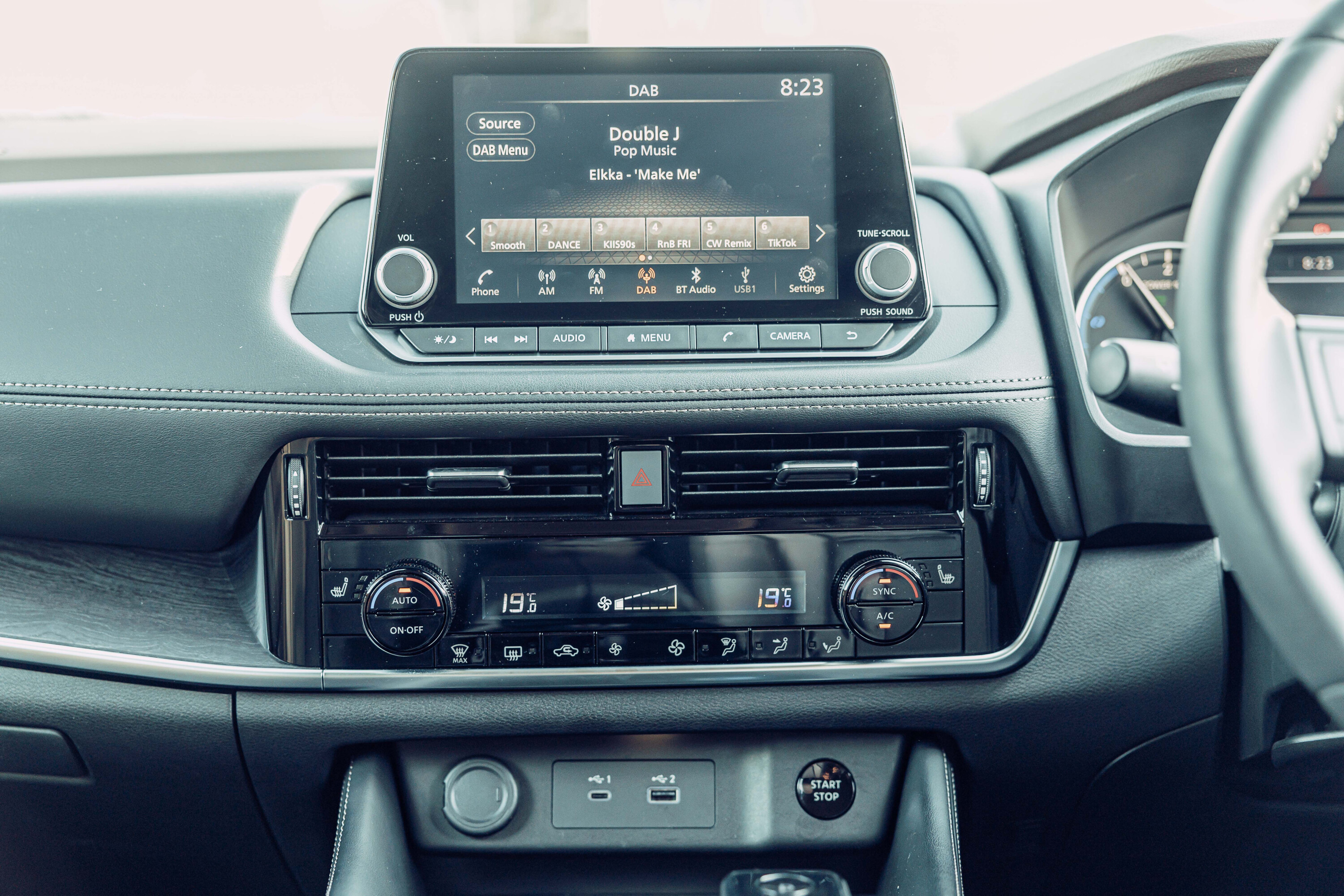
The difference is from having an electric motor providing direct drive to both the front and rear ends, and Nissan’s thrummy, punchy 1.5-litre turbo-petrol triple essentially acting as a range extender, with a switchable (and excellent) ‘e-Pedal’ mode to ramp up the regenerative braking for a near-EV driving flavour.
Because the electric motors are always transmitting grunt to the wheels, the e-Power X-Trail always feels crisply responsive – smooth in its movement and with a delightful elasticity when it eventually introduces petrol-driven motor force.
It’s lightyears ahead of the X-Trail’s other drivetrain choice (a dependable, if vocal, 2.5-litre direct-injection petrol four) and gives the Nissan a distinct point of difference compared to its hybrid rivals.

The X-Trail’s keen, slack-free steering enhances the e-Power effect – geared to just 2.5 turns lock-to-lock (spanning an 11.1m turning circle) for immediate front-end response, especially around town.
Combined with the drivetrain’s effortless thrust, it makes the hybrid X-Trail feel lithe and spritely. Out on challenging country roads, that impression continues, with the suspension coping pretty well with lumps and bumps, though it isn’t super-quiet when dealing with road hits, and the X-Trail does tend to rock around a bit. But it doesn’t lose its composure either – placing the Nissan in another dynamic league compared to its predecessors.
Facing a handsome, neatly dished three-spoke steering wheel, the X-Trail’s driving position is terrific – even seated on the ST-L’s vinyl (as opposed to the Ti-L’s lovely quilted Nappa leather) – the switchgear is consistently good-quality and everything appears elegantly styled and easy to operate.

There’s also a large, rubberised tray beneath the floating centre console that becomes unexpectedly useful the longer you live with the X-Trail.
And we’re essentially referring to the $50K ST-L version here. The $8500-dearer Ti-L really does feel premium inside, especially with optional tan-coloured seat, dash and door upholstery.
Both front doors effortlessly take a one-litre camping bottle while the rear seat, just like the previous model, offers a true theatre seating experience – elevating second-row passengers higher than the front buckets for a supreme view, which is enhanced by the seat cushion being fore-aft adjustable over a substantial range.

The Ti e-Power brings tri-zone climate control, a vast panoramic sunroof and an electric tailgate for the impressively large 575-litre boot, while the Ti-L adds outboard rear-seat heating and rear door sunshades.
Ownership-wise, it’s the X-Trail’s average projected resale value that ultimately lets it down slightly – placing the Nissan on par with a Volkswagen Tiguan or Skoda Karoq, but a few percentage points below a Mazda CX-5, Hyundai Tucson, Kia Sportage or Honda CR-V.
And the cost of its servicing (every 12 months or 10,000km) is about average as well – $2020 if you buy a five-year servicing plan, or $2244 if you don’t.
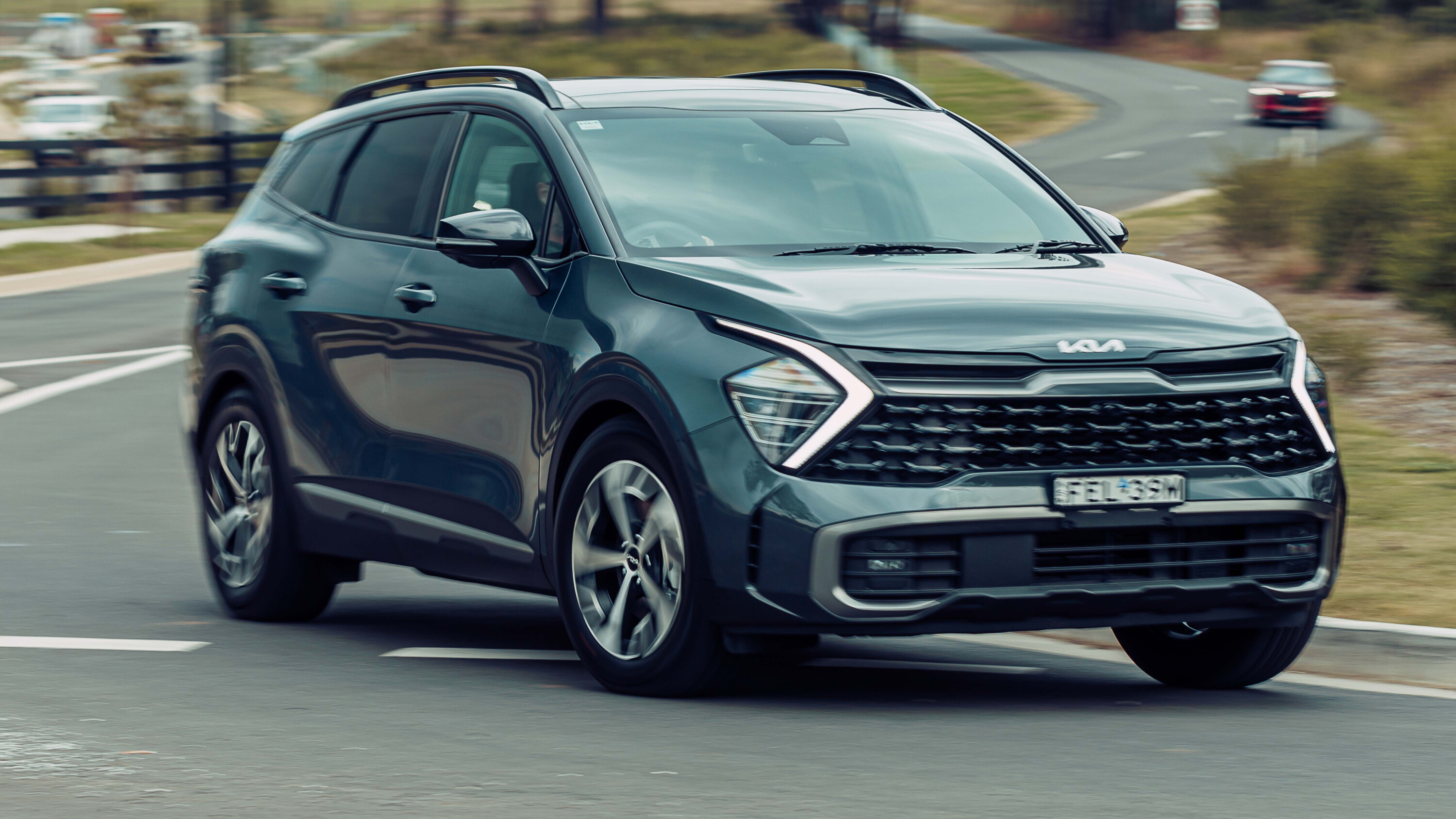
Kia Sportage GT-Line hybrid
Overseas markets have had access to a Sportage Hybrid since the current NQ5 generation launched in late-2021, though given the recent surge in popularity of hybrid-engined vehicles in Australia, the petrol-electric Sportage’s better-late-than-never entrance couldn’t be better-timed.
There’s already a several-month waiting list for the two hybrid variants (SX and GT-Line), which Kia expects will account for at least 20 percent of the model mix, though Sportage volume is up 62 percent so far in 2024, without the help of the Hybrid. So if these promising new variants catch on, the Kia Sportage may soon be as common as teen angst in a neighbourhood near you.
Based on the overall performance and driveability of the Sportage Hybrid, it certainly deserves a generous slice of the action.
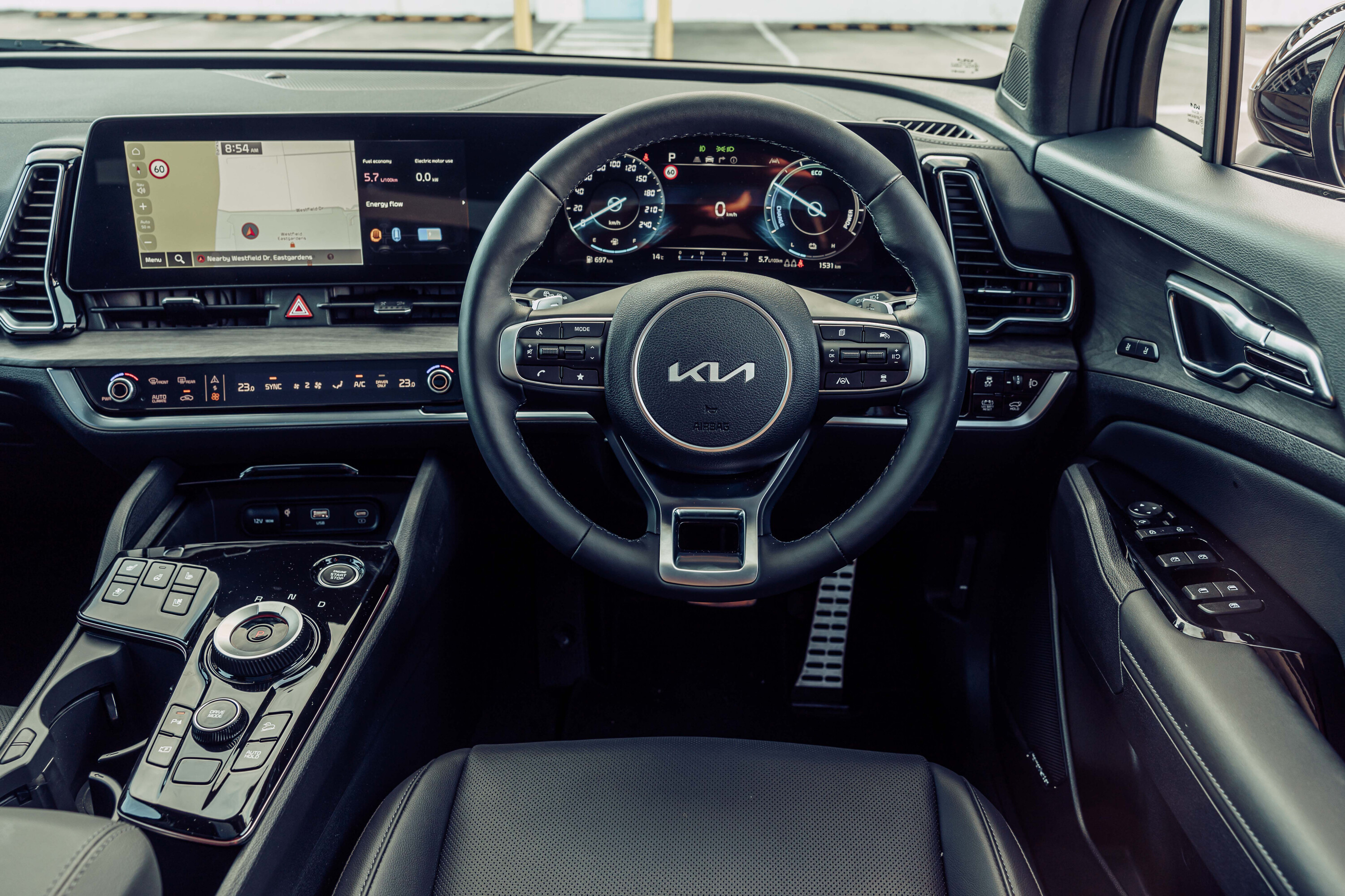
The 169kW/350Nm 1.6-litre turbo-petrol four-cylinder hybrid delivers deceptively strong acceleration, perhaps because its auto transmission possesses just six tall ratios, and feels silkier than the two regular boosted Sportage engines.
Kia’s hybrid isn’t as tuneful or as sweet-spinning as Honda’s naturally aspirated e:HEV, though it does have loads of torque – the engine peaking at 1500-4500rpm, the electric motor at 1600rpm – so if you drive the Sportage with a relaxed keenness, it’s effortlessly smooth and swift. But with no regenerative braking effect, it feels quite different to the X-Trail’s e-Power set-up.
The Sportage has a more commanding driving position than its rivals, and while its leather/Alcantara front buckets aren’t as huggy as the Honda’s, they’re nicely supportive and very comfortable over big distances.
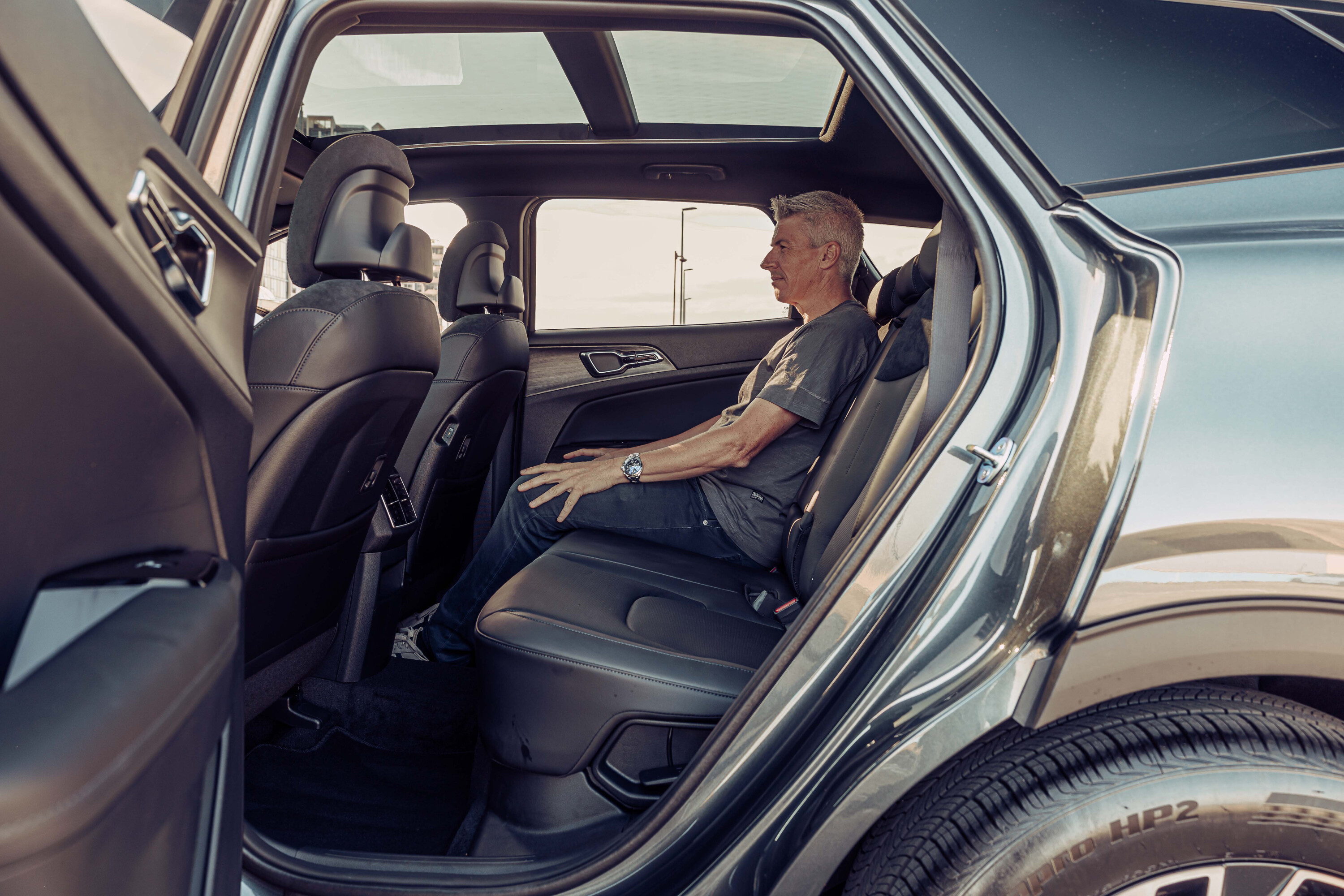
They also include three-stage heating and cooling, and with proper eight-way electric adjustment (meaning height and under-thigh tilt), the front passenger doesn’t feel like they’ve turned up to an LNP fundraising barbecue dressed in Hawke’s Brewing merch.
With its impressive 12.3-inch screens, brilliant switchgear functionality (apart from some safety-assist disablement), the airy expanse of its panoramic sunroof and even its classy dashboard stitching, the Sportage GT-Line’s cabin is an accommodating place.
Great rear seat, too, with excellent leg and toe room – complemented by a huge 586-litre boot with a dual-height floor that can swallow a serious amount of stuff.
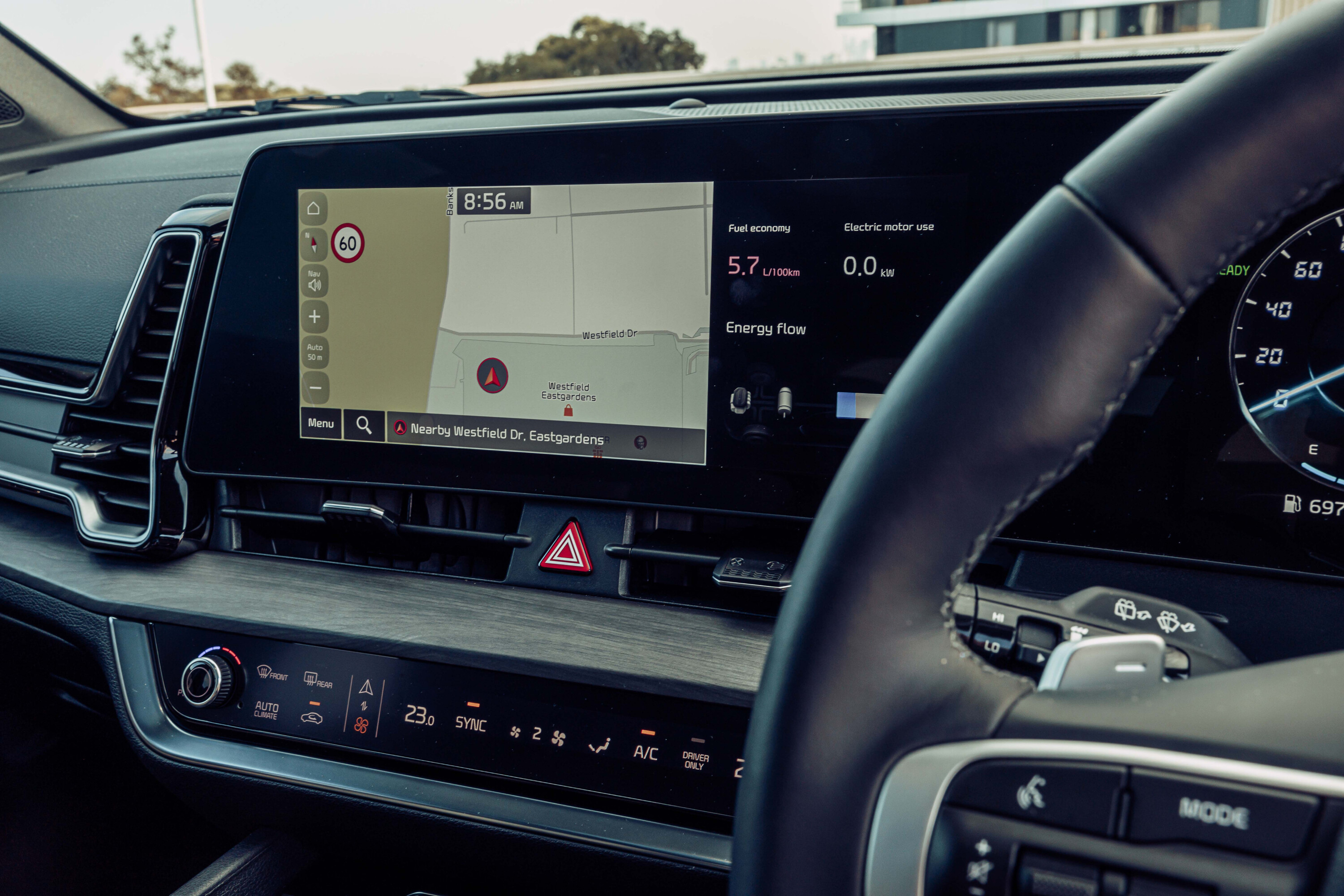
But why does everything have to be so dark?
The GT-Line’s all-black interior (including the headlining) is oppressively dour – alleviated to a large degree by the glassiness of its cabin and the technicolour of its screens – and even the stitching is monotone black, making the flagship Sportage feel less premium than it could, or indeed should.
Does a contrasting colour really cost extra? Why does the dash trim insert look like it was designed by Crocs? And while we’re at it, why do the doors only take 600ml plastic bottles, in an era where PET consumption is such a huge issue?
Pedantry aside, what makes the Sportage Hybrid experience is its dynamics. Even wearing unsporting rubber (and only 18-inch alloys on GT-Line, instead of the 19s from the petrol/diesel), it’s a terrific handler.
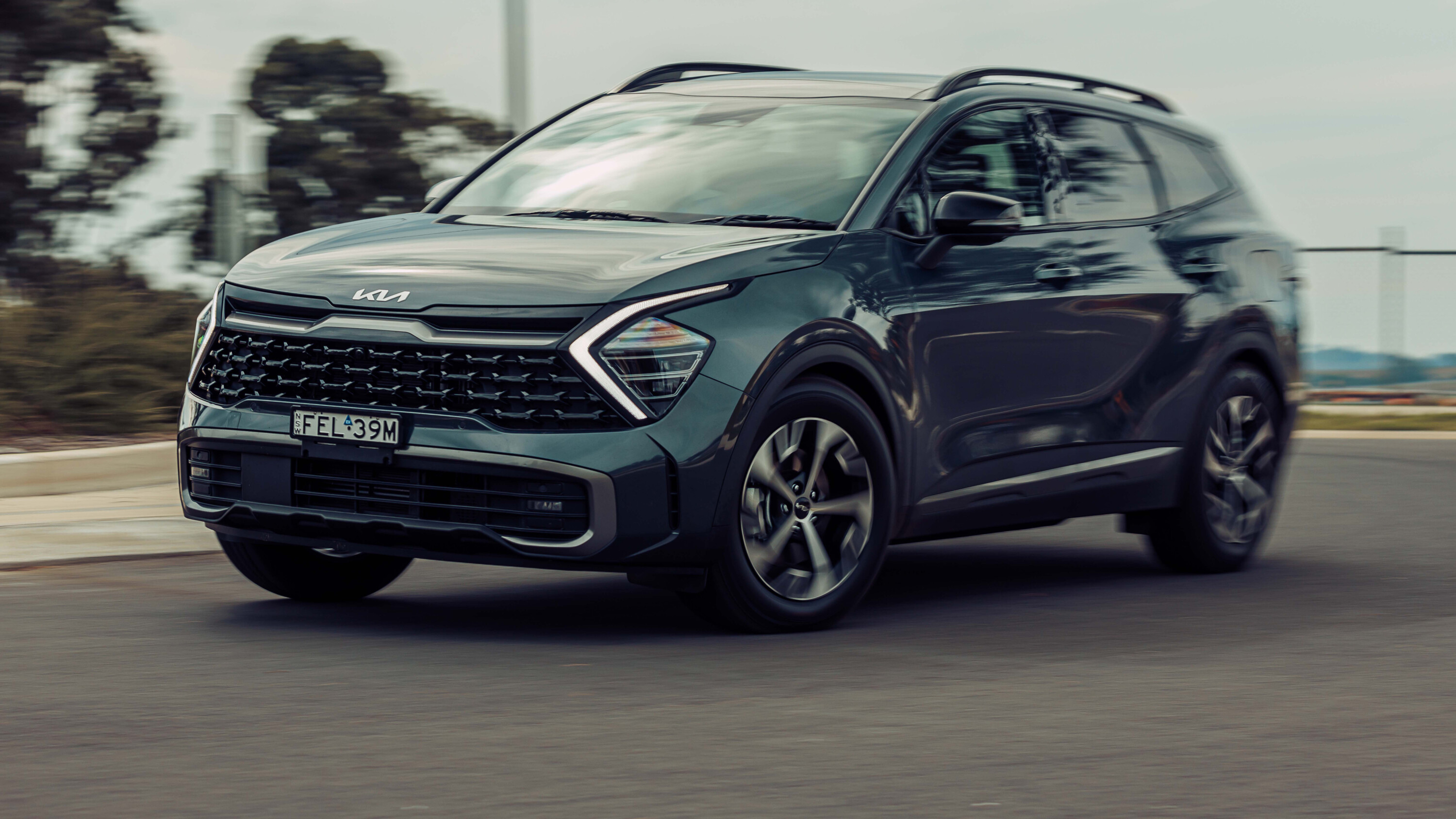
Always poised and composed, its lightly weighted steering at low speeds makes you suspect that it’s going to be all ‘electriccy’ once on the move, but it weights up naturally and is pleasingly accurate – making the unassuming Sportage surprisingly pointy.
It has a more natural dynamic flow than the X-Trail – feeling more ‘all-of-a-piece’ – and it’s more of a driver’s car than the Honda in terms of handling and steering, plus it has that extra engine torque. It’s also more consistent in its composure than the big-selling Toyota – maintaining Kia’s reputation for delivering terrific all-round suspension tunes for Australia.
It handles big bumps more effortlessly than the Nissan and Toyota, though its ride isn’t as quiet or as supple as the Honda’s. The Kia has an initial firmness that the Honda smooths over quite beautifully, though when it’s really challenged, the Kia demonstrates absorbency and control.
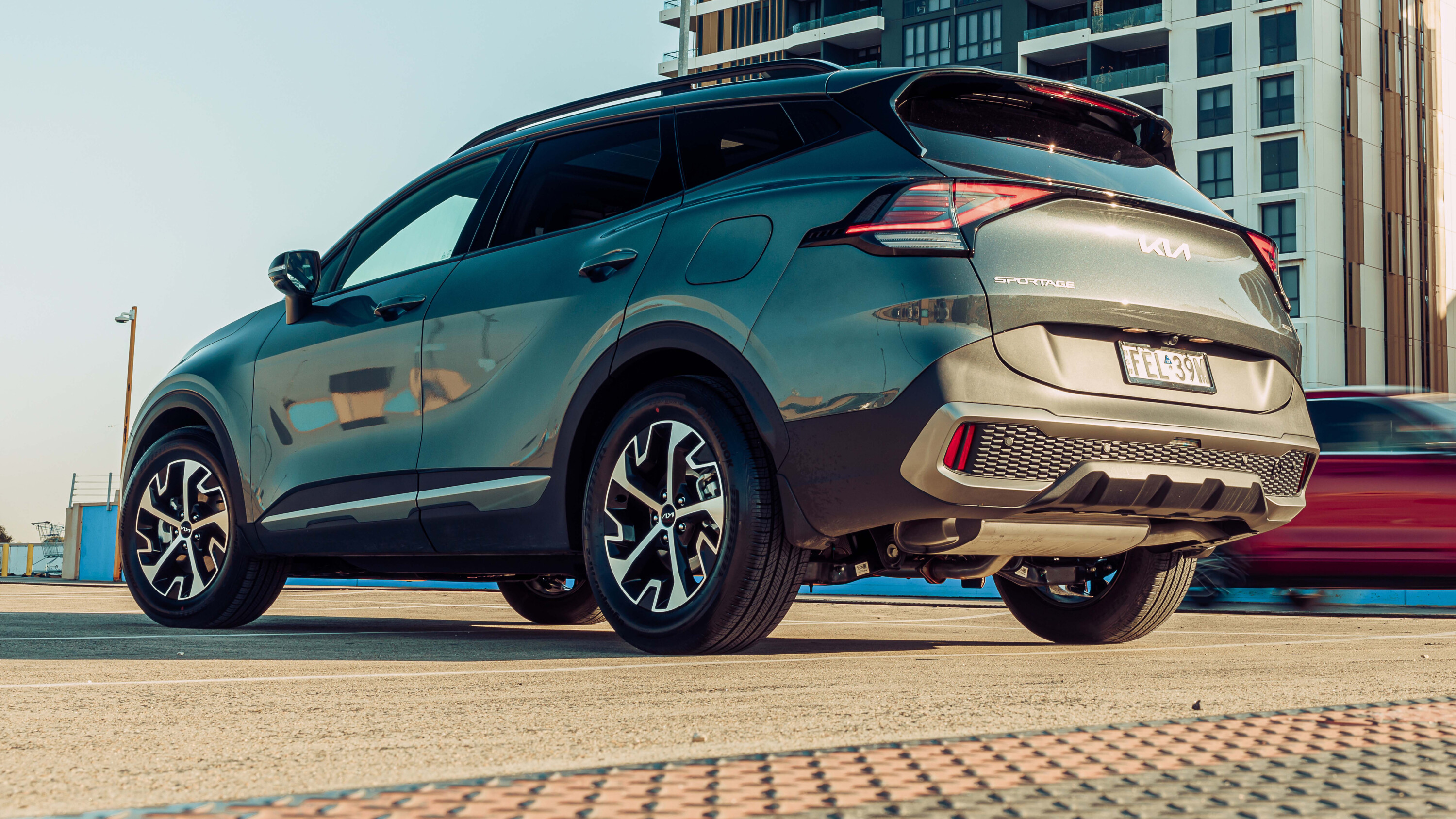
It’s the sort of car where you don’t need to slow down on a bad road – it simply cops what it gets served.
Ultimately, the Sportage Hybrid is not quite as polished or refined as the CR-V e:HEV in its overall driving experience, and it can’t match the Honda’s feeling of expense in cabin presentation. Or its super-cheap $995 servicing cost over five years.
Across the same period, the GT-Line Hybrid is almost $2000 more expensive to service, as well as $500 more to drive away from the dealership in the first place than the CR-V e:HEV RS … though at least Kia offers a cheaper Sportage SX Hybrid alternative (from $46K).

Honda CR-V e:HEV RS
Our first-ever medium SUV Megatest – published in May 2003 – awarded gold to the second-generation Honda CR-V Sport.
Based on the quality of its drivetrain performance, its excellent seating comfort and interior flexibility, the CR-V just managed to elbow out the second-gen Subaru Forester. Yet despite its greatness in these areas, it was impossible to ignore the ’03 CR-V’s steering kickback, understeer, body-control laziness, and road noise – aspects that would crucify any SUV’s chances today.
Two decades later, we’re in a completely different universe. The sixth-generation CR-V e:HEV RS is almost exemplary in its dynamic behaviour – to the point where its controlled suppleness and level of refinement make acquiring this hybrid flagship for $59,900 drive-away seem like incredible value for money.
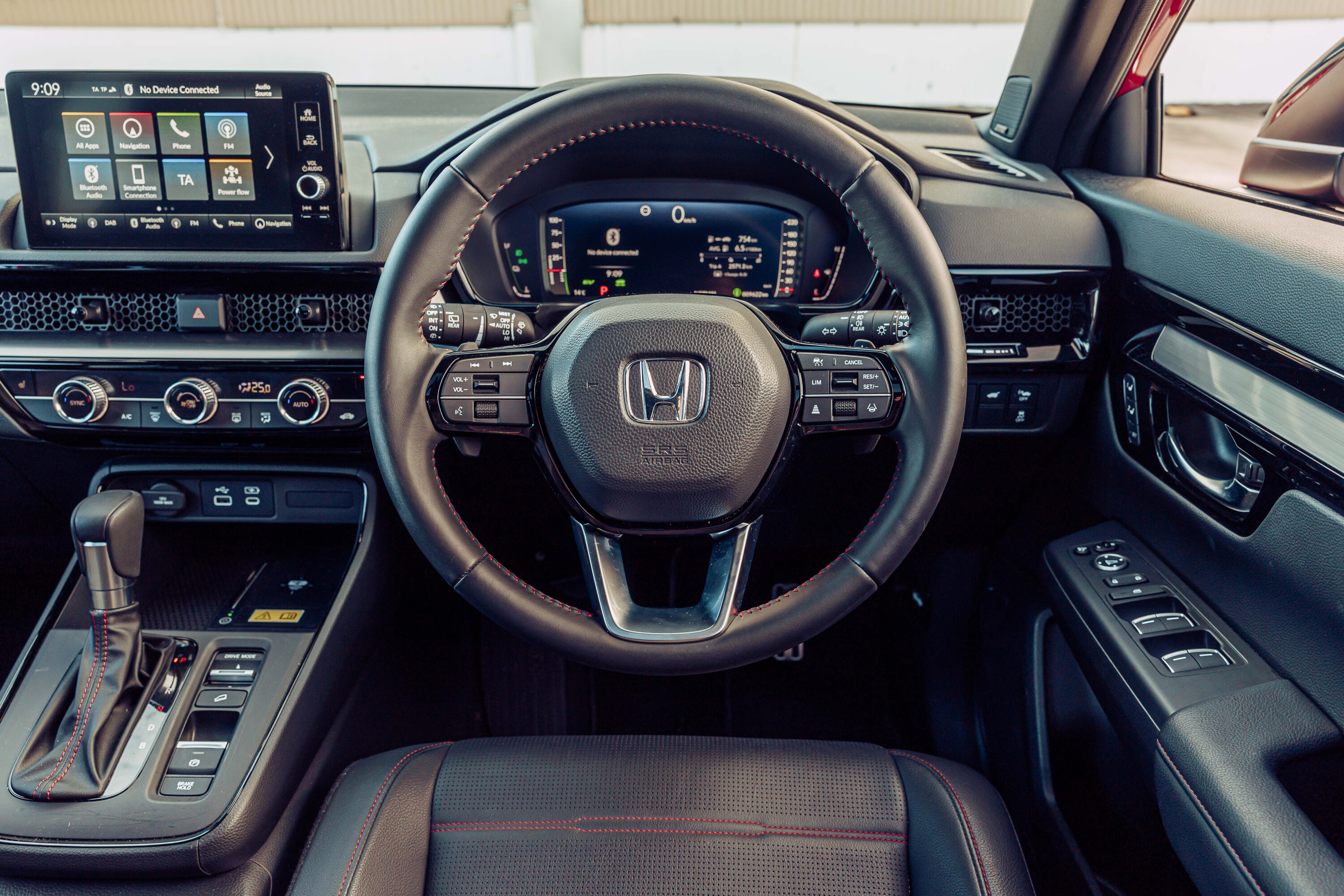
“If only a Lexus NX drove like this,” said one tester – a premium medium SUV that starts at $62,275 (before on-road costs) and stretches all the way to $90K. “If only every other CR-V before this drove like this,” was my thinking because, jeez, we’ve been waiting a long time.
The new CR-V cedes steering crispness to the RAV4, and sporty handling/ride discipline to the Sportage, yet none of its rivals can quite match its blend of all-round suaveness. Steering response is perhaps a little too measured deviating from straight ahead – more of the Civic’s incisiveness would be appreciated here – but the CR-V’s poised handling is satisfying fun and it has a distinct whiff of (current) Honda DNA about it.
Aiding that impression is its lovely drivetrain – a 2.0-litre ‘Atkinson cycle’ direct-injection four-cylinder combined with a pair of electric motors driving the front wheels through an e-CVT transmission with stepped ratios under engine acceleration.
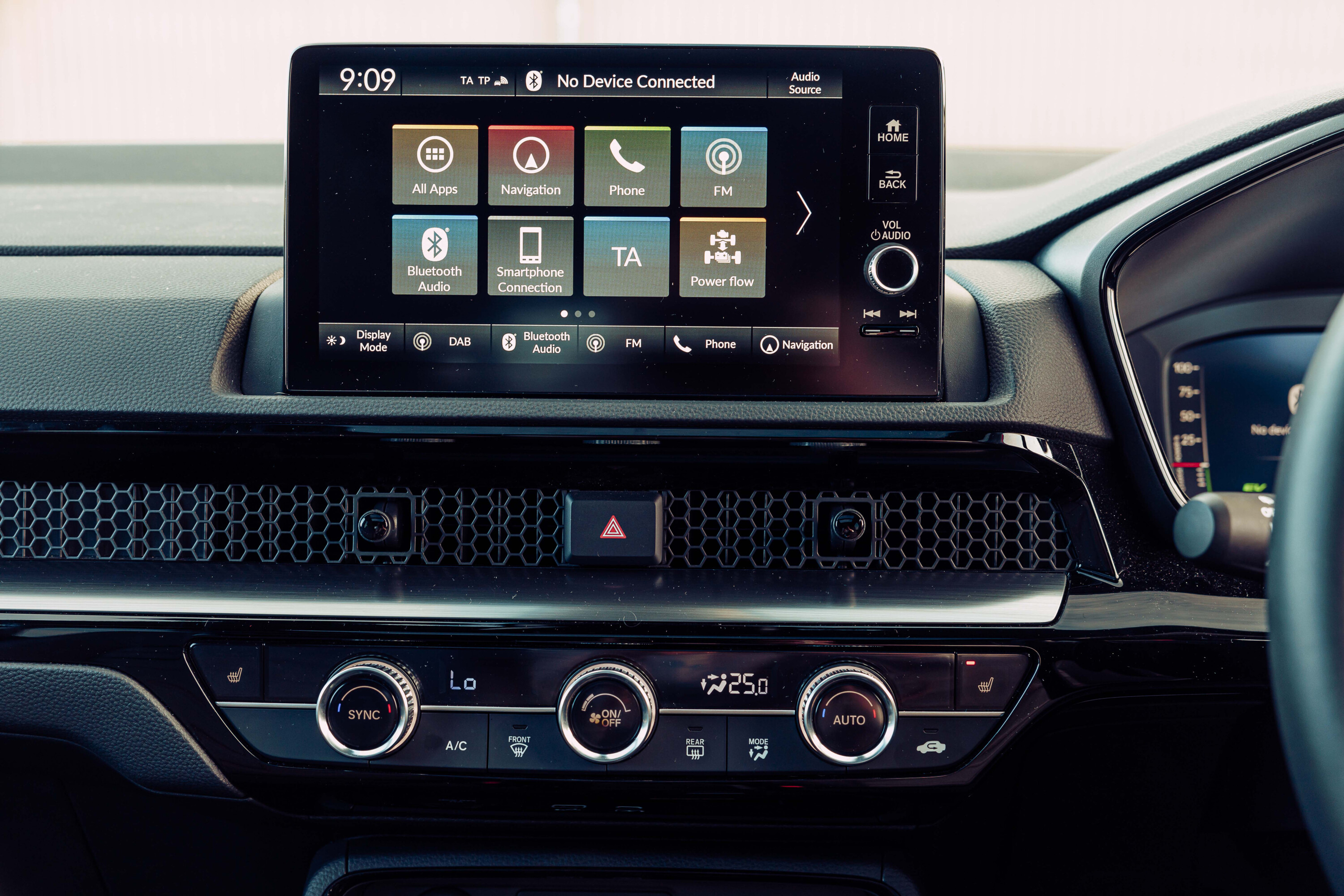
It accelerates like a zingy Honda auto from the past
In a similar fashion to Nissan’s e-Power, the Honda e:HEV system can decouple the engine from the hybrid system when it isn’t needed, though it drives like a normal hybrid rather than the EV-of-sorts X-Trail, with its clever ‘e-Pedal’ regenerative braking. And it accelerates like a zingy Honda auto from the past, rather than blasting loudly at a set rev point like the CVT Toyota.
Producing 152kW of system power, the Honda drivetrain is in the ballpark of the X-Trail (157kW), RAV4 (163kW) and Sportage (169kW), and while its 9.4sec 0-100km/h acceleration claim seems a bit off the pace, it almost never feels wanting for grunt on the road.
Driveability is superb – backed by a smoothly sonorous engine that packs a delightful level of induction fizz when pressed – and the transition from petrol to electric is seamlessly refined. Even though the CR-V doesn’t have the foot-flat shove of the X-Trail, it more than makes up for it with the quality of its performance.

Indeed, that description rings true with everything about the sixth-gen CR-V.
Not only is it a really handsome design, with sequential front indicators in the LED-equipped RS to enhance its specialness, but it backs that up with a high-quality interior brimming with neat touches – all clearly inspired by the current-generation Civic that finally elevated Honda back to its rightful position.
The RS’s heavily bolstered front buckets with perforated leather and red stitching are excellent – even though the front passenger only gets archaic four-way electric adjustment (plus no fan-chilling for either chair) – while the spacious rear bench is equally sumptuous, with the added benefit of a near-flat floor. Only the drop in door-trim tactility from front to rear betrays any cost-cutting.
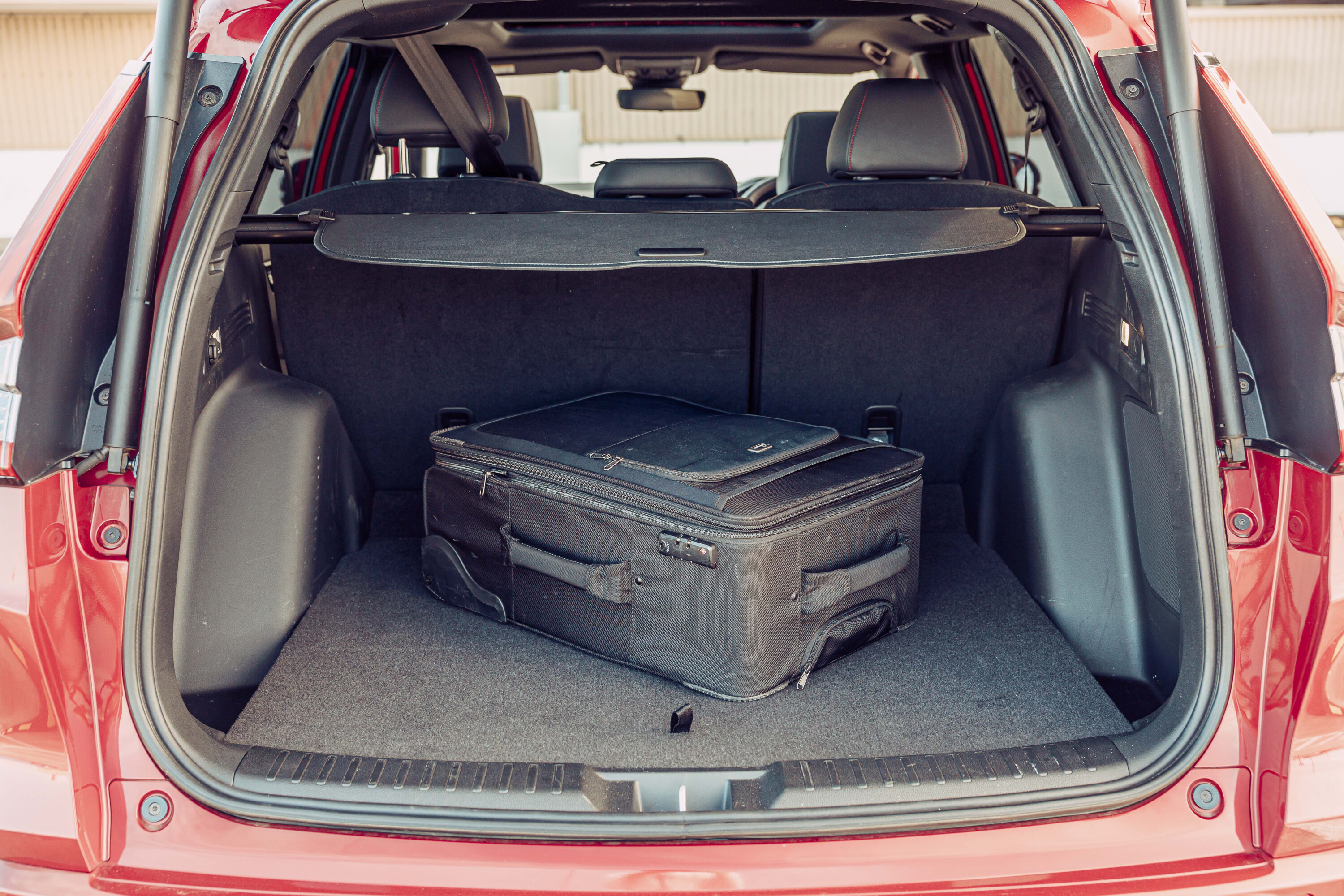
The classy dashboard is soft-touch and neatly designed, complimented by a superb steering wheel, slick 10.2-inch driver display and simple 9.0-inch touchscreen with wireless Apple CarPlay and 12-speaker Bose audio.
There’s also a brilliant-to-use HVAC system, a clever ‘magic fold’ rear seat that tumbles onto itself as the cushion lowers (ala first-gen Mazda 6’s ‘Karakuri’ system), and a superbly trimmed boot, with plush carpet worthy of a decent hotel and an almost-flat floor when the rear seat is dropped.
The CR-V manages to squeeze a one-litre camping bottle into its front doors, and all-round vision through its panoramic roof and out its Kia EV9-esque windscreen expanse is tremendous.
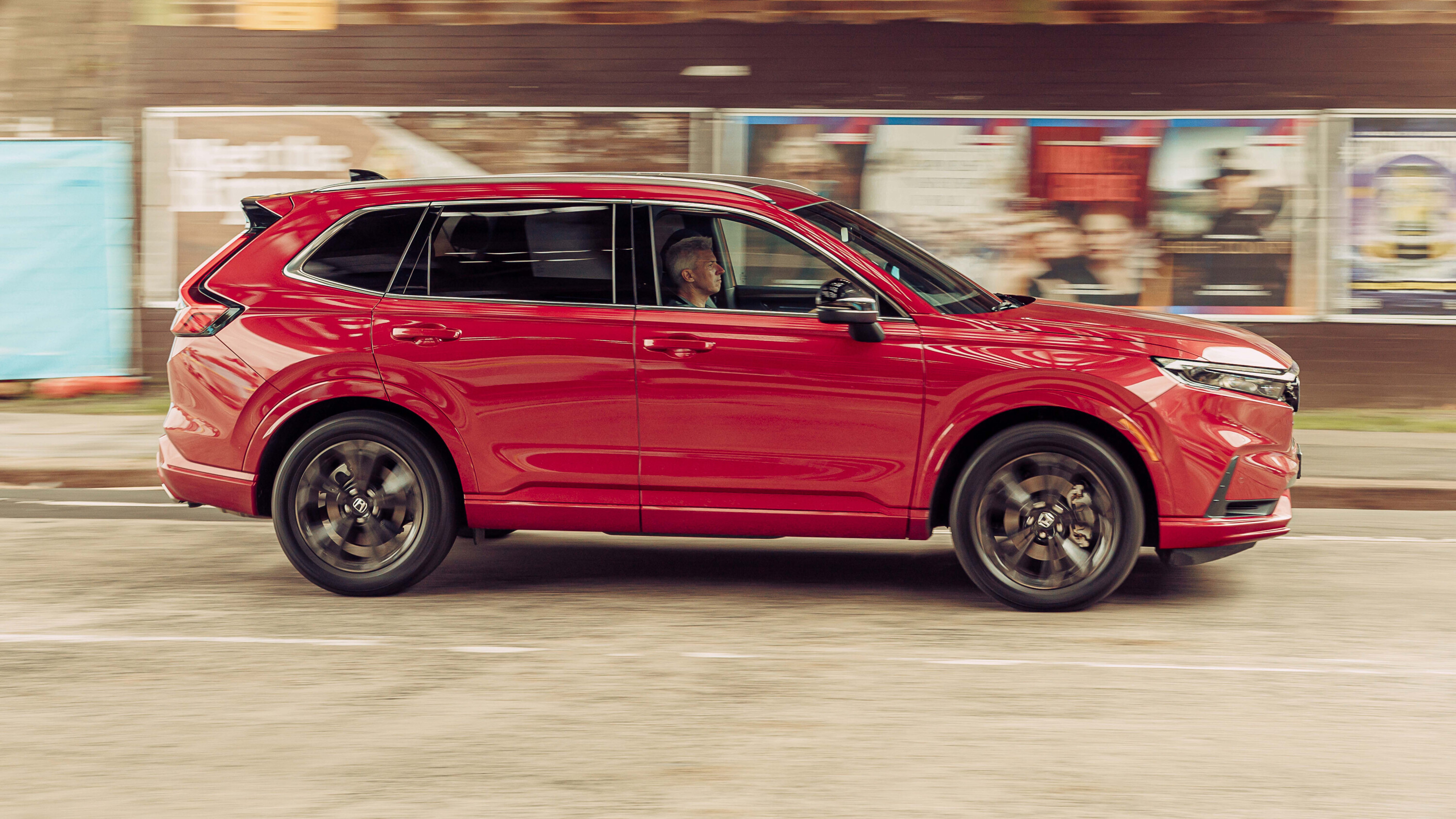
What ultimately hits home is that the CR-V e:HEV RS’s interior – just like its dynamics and its drivetrain – feels premium.
Given the revival of this once-expected level of Honda build quality, it’s really quite astounding that the flagship CR-V’s drive-away price sits smack-bang in between the RAV4 Cruiser and Sportage GT-Line, and several grand below the X-Trail Ti-L e-Power. And that it’ll cost less than a grand to service for the first five years. It makes you wonder what the catch is. The best part is, there isn’t one.
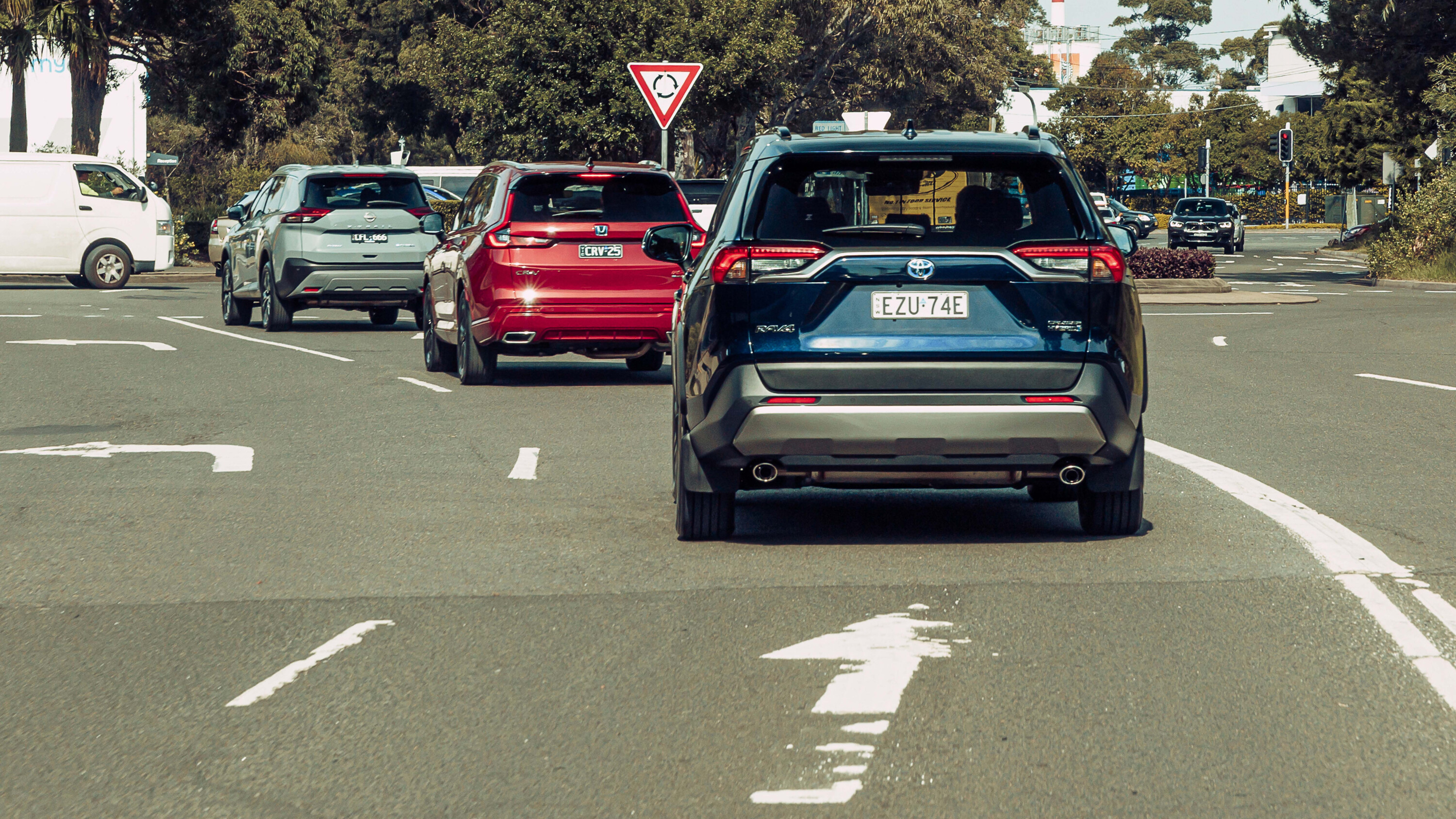
VERDICT
It’s reassuring at the end of a four-car comparo as relevant as this to know that every hybrid medium SUV tested here is a really strong choice.
We’d happily live with any of them, for a multitude of different reasons, and they each possess a degree of unique flavour that makes them distinct.
As an all-rounder, the RAV4 Cruiser Hybrid e-Four is difficult to beat. It does very little wrong, gets pretty much everything right when it comes to ownership, and is rewarding to drive as well.
Yet it’s also starting to age – both from a design perspective and a refinement perspective – so when scrutinised under the harsh microscope of a Wheels comparison test, it’s no longer the top dog when it comes to hybrid medium SUVs. Honourable mention? Without question. But it’s not the all-conquering powerhouse it once was.
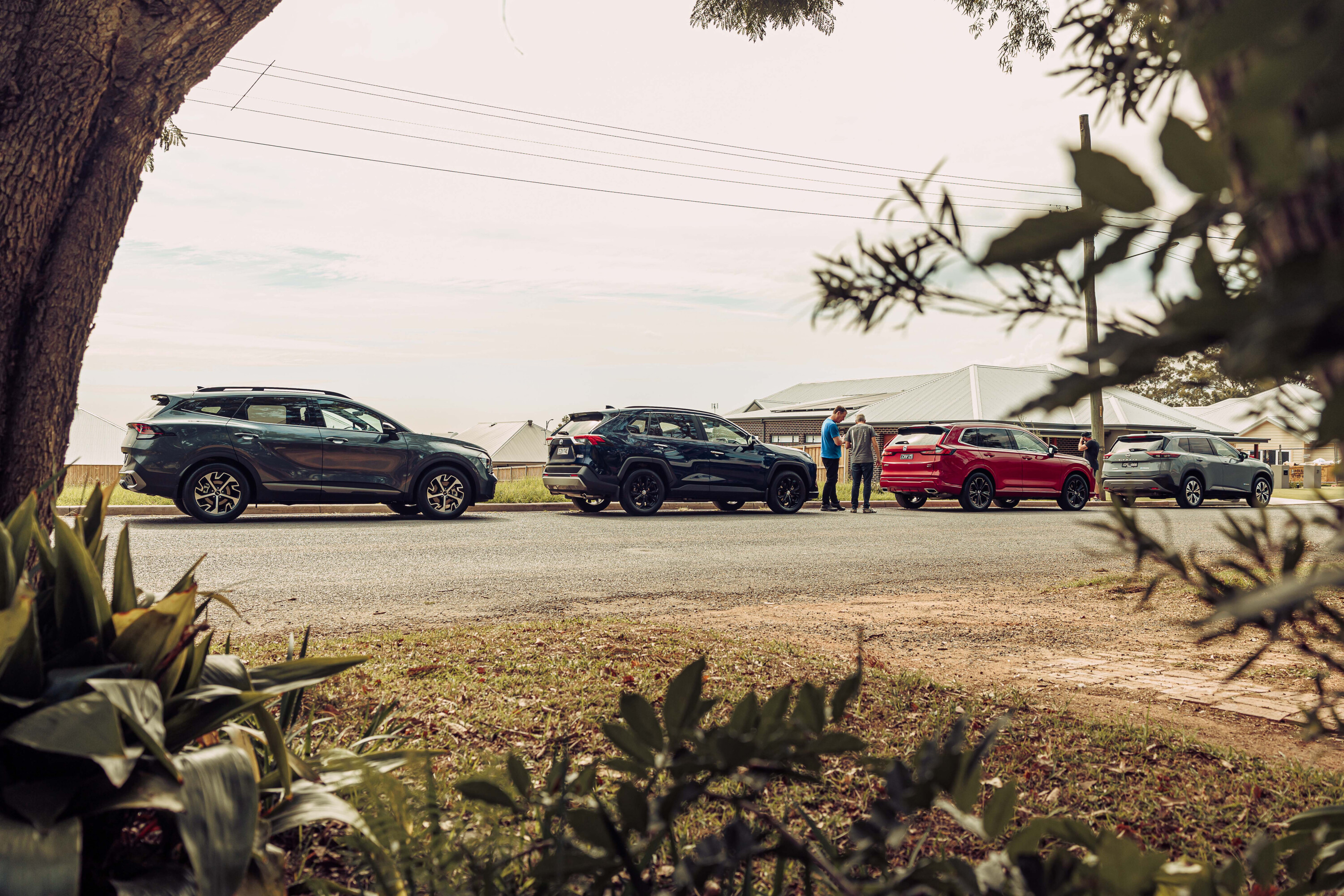
The X-Trail e-Power is an intriguing alternative to a RAV4 Hybrid.
When it hits its high notes, it’s truly impressive, and no one can dispute the excellence of its drivetrain performance, the quality and functionality of its interior, and the dynamic agility accessed via its sharp steering.
It’s a bloody good car – way better than most people probably expect an X-Trail to be – and if it proves to be a reliable long-term proposition, then its lacklustre residual value should eventually even out. In Ti-L form, this is a Nissan SUV that exudes premium quality.
But both the Sportage and CR-V edge it out for all-round ability – the Kia by the tiniest of margins due to its refinement, its all-surface dynamic distinction and its warranty, and the Honda because this sixth-generation CR-V is arguably the first of its kind to truly channel the excellence of the brand’s late-80s glory days.

And given that the $60K drive-away Honda also seems like surprisingly good value for money, what’s not to love?
It’s beautifully put together, agreeably handsome, and has some pukka Honda character – which, as a complete statement, has applied to so few Hondas this century, and a CR-V arguably never!
So as a belated return to form, what better category to nail the brief than among medium SUVs. Here’s hoping the new CR-V’s silky sheen somehow rubs off on Honda’s future products.
| Model | Score |
|---|---|
| Toyota RAV4 | 7.5 |
| Nissan X-Trail | 8 |
| Kia Sportage | 8 |
| Honda CR-V | 8.5 |
Specifications
| 2024 Toyota RAV4 Cruiser e-Four | 2024 Nissan X-Trail ST-L e-Power e-4orce | 2024 Kia Sportage GT-Line Hybrid | 2024 Honda CR-V e:HEV RS | |
|---|---|---|---|---|
| Price | $54,410 (before on-road costs) | $49,990 (before on-road costs) | $55,420 (before on-road costs) | $59,900 (drive-away) |
| DRIVETRAIN | ||||
| Engine | 2487cc 4cyl, dohc, 16v, direct injection | 1497cc 3cyl, dohc, 12v, turbo | 1598cc 4cyl, dohc, 16v, direct injection, turbo | 1993cc 4cyl, dohc, 16v, direct injection |
| Electric motor | Permanent magnet synchronous | Front and rear permanent magnet synchronous | Front permanent magnet synchronous | Two front permanent magnet synchronous |
| Battery | 2.1kWh lithium-ion | 1.49kWh lithium-ion polymer | 1.06kWh lithium-ion | |
| Compression ratio | 14.0:1 | Variable | 10.5:1 | 13.9:1 |
| Drive | All-wheel drive | All-wheel drive | Front-wheel drive | Front-wheel drive |
| System power | 163kW | 157kW | 169kW | 152kW |
| System torque | not available | not available | 350Nm | not available |
| Transmission | CVT automatic | CVT automatic | 6-speed automatic | CVT automatic |
| CHASSIS | ||||
| L/W/H | 4615/1855/1690mm | 4680/1840/1725mm | 4660/1865/1680mm | 4704/1866/1681mm |
| Wheelbase | 2690mm | 2705mm | 2755mm | 2701mm |
| Track (f/r) | 1595/1605mm | 1585/1590mm | 1615/1622mm | 1611/1627mm |
| Weight | 1755kg | 1871kg | 1738kg | 1771kg |
| Boot | 542-580 litres | 575 litres | 586 litres | 581 litres |
| Fuel/Tank | 91 RON/55 litres | 95 RON/55 litres | 95 RON/52 litres | 91 RON/57 litres |
| Economy | 4.8L/100km (combined), 5.6L/100km (tested) | 6.1L/100km (combined), 6.2L/100km (tested) | 4.9L/100km (combined), 6.3L/100km (tested) | 5.5L/100km (combined), 6.1L/100km (tested) |
| Suspension front | struts, A-arms, anti-roll bar | struts, A-arms, anti-roll bar | struts, A-arms, anti-roll bar | struts, A-arms, anti-roll bar |
| Suspension rear | double wishbones, coil springs, anti-roll bar | multi-links, coil springs, anti-roll bar | multi-links, coil springs, anti-roll bar | multi-links, coil springs, anti-roll bar |
| Steering | Electric power-assisted | Electric power-assisted | Electric power-assisted | Electric power-assisted |
| Tyres | Bridgestone Alenza | Dunlop Grandtrek PT21 | Hankook Dynapro HP2 | Michelin Latitude Sport 3 |
| Tyre size | 225/60R18 100H | 235/60R18 103H | 235/60R18 103H | 235/55R19 101Y |
| Towing capacity | 1500kg (braked) | 1650kg (braked) | 1650kg (braked) | 750kg (braked) |
| SAFETY | ||||
| ANCAP rating | 5 stars | 5 stars | 5 stars | 5 stars |
| 0-100km/h | 8.0sec (tested) | 7.0sec (claimed) | 8.0sec (claimed) | 9.4sec (claimed) |
We recommend
-
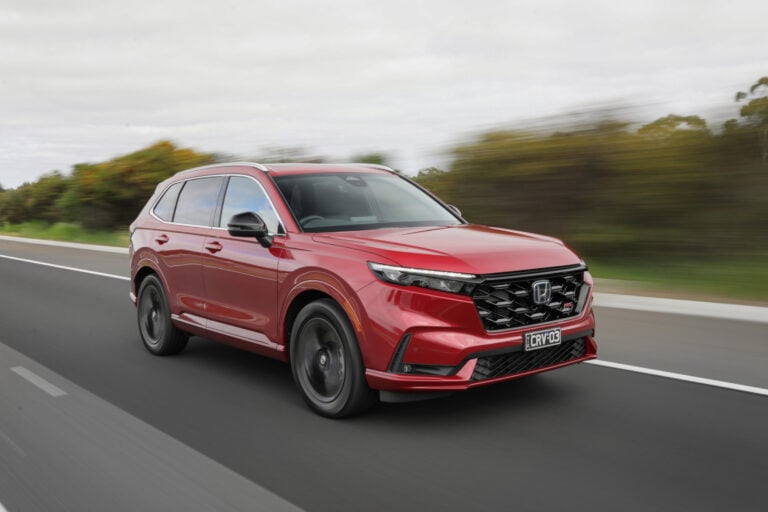 Reviews
Reviews2024 Honda CR-V review: Australian first drive
Could the all-new CR-V be the answer to Honda's prayers as it works to regain market share?
-
 Electric
Electric2024 Best Electric Midsize SUV: Kia EV6
Ford, Subaru and Toyota have all joined the legacy carmakers taking on the Tesla Model Y, but it's our 2022 Wheels Car of the Year that remains unmoved as the pick of the class
-
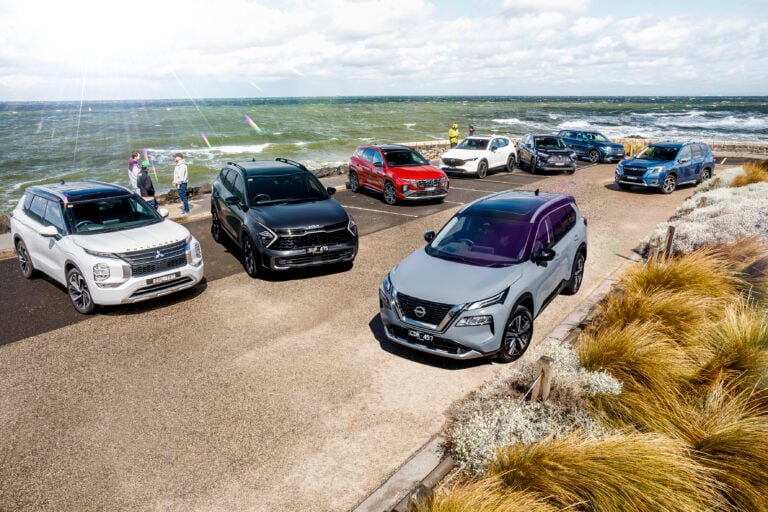 Comparisons
ComparisonsBest Medium SUV 2023: Family Car Comparison
Thinking of buying a new mid-size SUV this year? We test eight of the best and most popular contenders to see where you should spend your money

